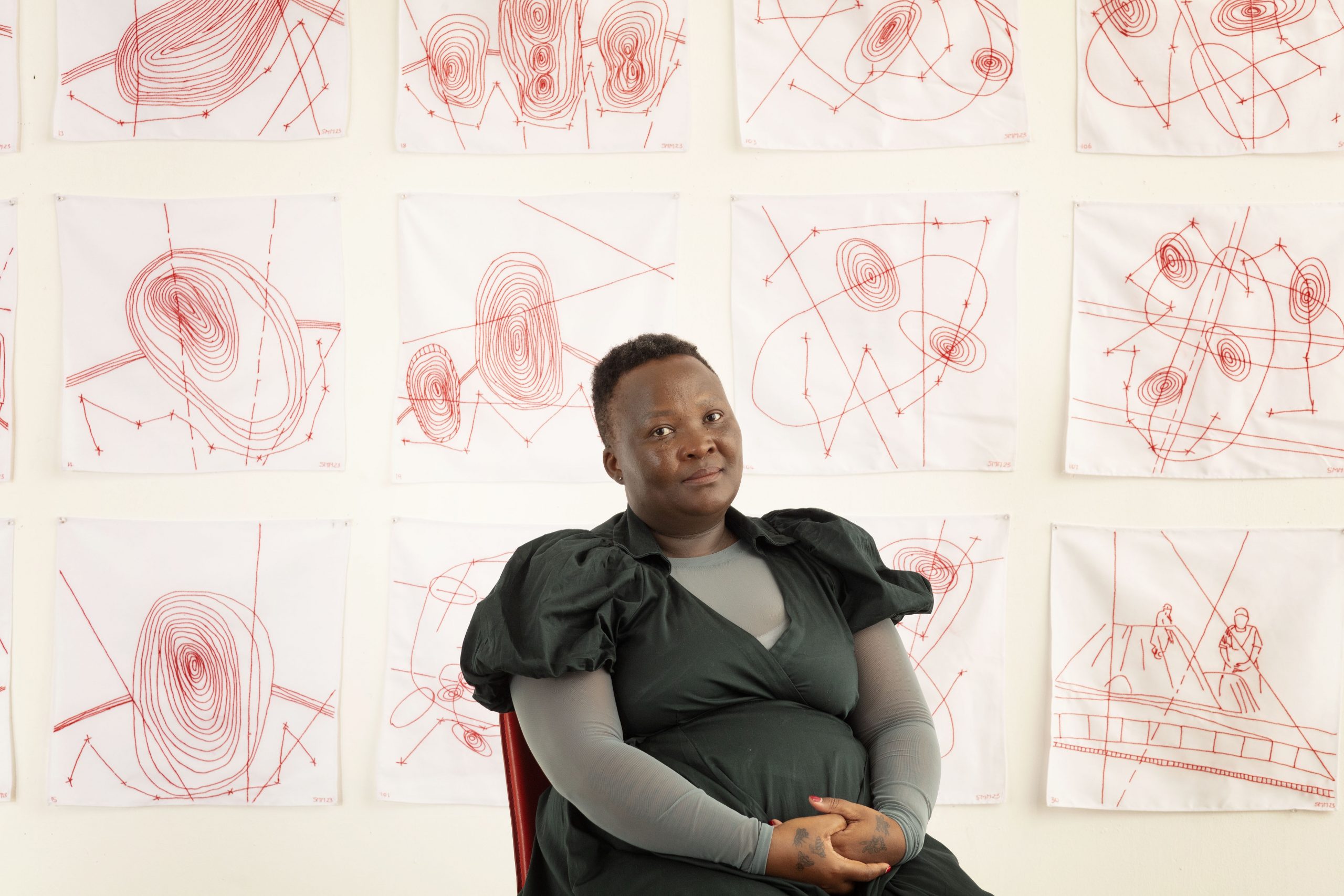
Coming soon
Coming soon
Select type

This edition, Art Rotterdam welcomes several new exhibitors including the Johannesburg based Kalashnikovv Gallery. The gallery is dedicated to providing a platform to both emerging and established South African artists. One of them is the interdisciplinary artist Senzeni Marasela (1977, South Africa) who explores photography, video, prints and mixed-medium installations involving textiles and embroidery. Her work deals with history, memory, and personal narrative, emphasising historical gaps and overlooked figures. Although Marasela exhibits around the globe, it is the first time her work is shown at a Dutch art fair.

In her performance titled Waiting for Gebane (2013-2019), Marasela delves into the life of her alter-ego Theodora (named after her mother) and fictional husband Gebane who abandons her in a village in the Eastern Cape and travels to Johannesburg. The story starts with a modest red dress which she receives as a gift before he leaves. The ornamentally printed Iseshweshwe dress is worn by married women in Xhosa culture and is widely worn by the rural population. Marasela wears the garment daily for six years in a row, a powerful statement woven into the encounters she has. She also performed this project at the 56th Venice Biennale in 2015.
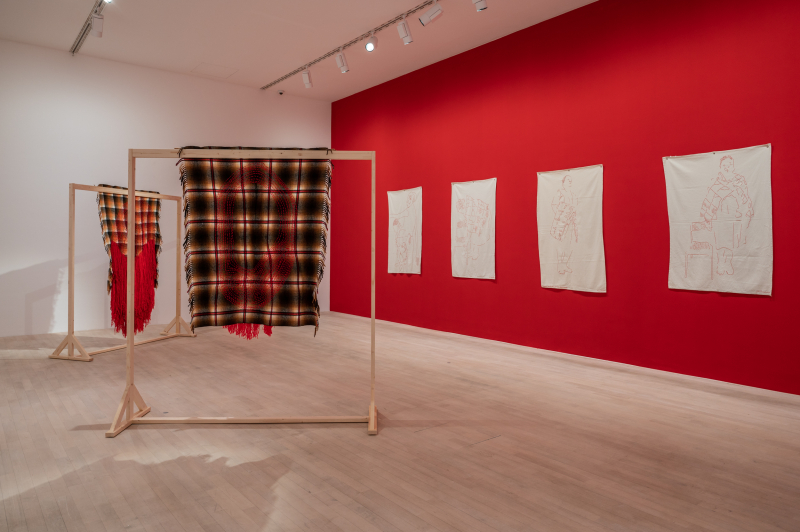
As the artist explains: “A large part of my work is concerned about covering Theodora. It is the hardships that she had to go through living in Johannesburg and probably also the hardships that women like me now are struggling with now. Because it’s a place with a lot of violence.” As such, Theodora remains not only a fictional character but also a way of giving voice to the traumas of Marasela’s mother and other black women, to this day.
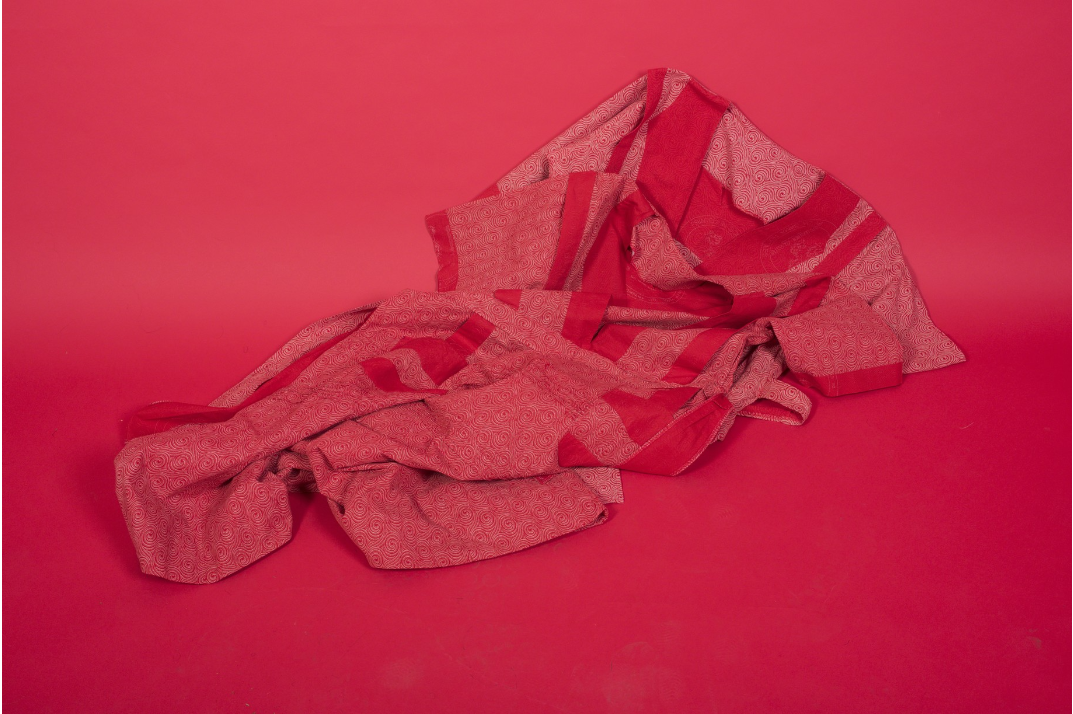
There is literally and figuratively a common thread in her work. The frequent use of the colour red in her embroidered works and watercolours, can be interpreted as a reference to the blood and evil behind colonial practices. Thematically, the artist makes invisible stories of oppressed black women visible. In her most recent series Last Known Location (2023), which the artist presents at Art Rotterdam, she uses topography to string together the story of Theodora in search of Gebane’s footprints.
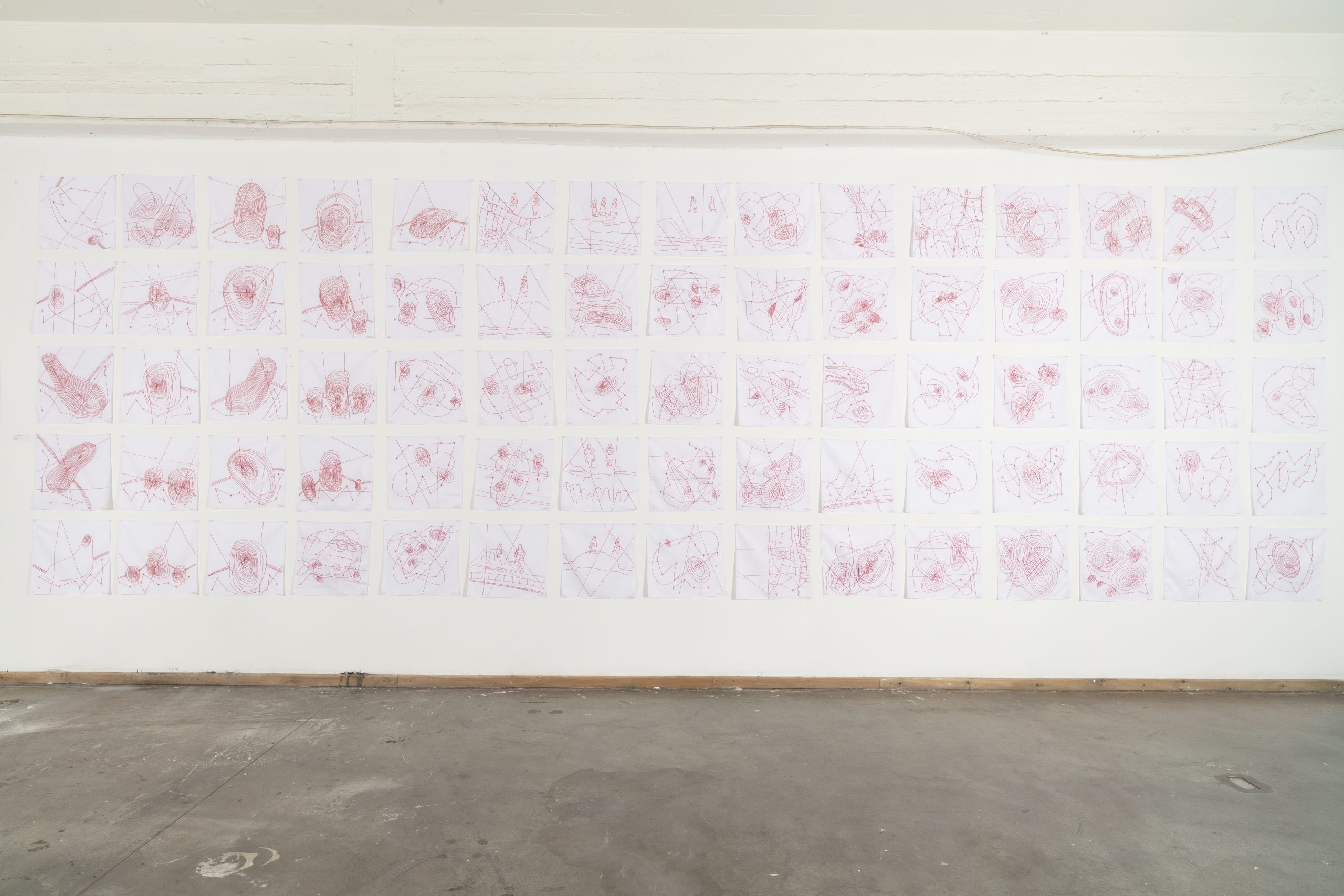
In earlier work Covering Sarah (2011), consisting of watercolours of red outlines in front of a white background, Sarah Baartman (1789-1815) is the main character. Baartman was a South African Khoikhoi woman who was required to perform in London and Paris in the 19th century. Tragically, she was used by Europeans to exhibit at rich people’s parties and private salons.
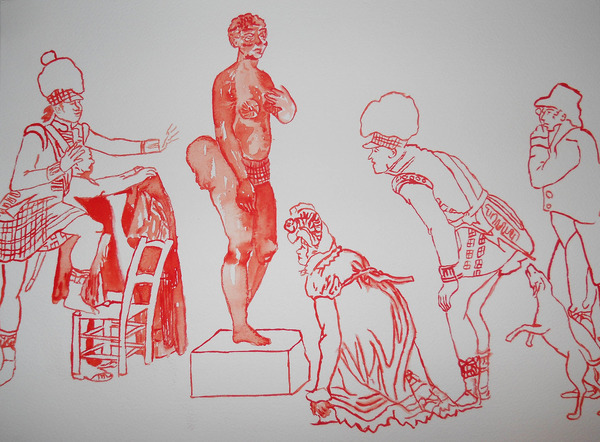
That her art has remained relevant and impactful for almost 30 years of artistry is reflected in the recent award Marasela received. In 2023, the artist won the first K21 Global Art Award, an initiative from the Friends of Kunstsammlung Nordrhein-Westfalen which celebrates the vision and courage of emerging and mid-career artists. She responds: “I hope that this is the beginning of great discussions and cooperations. I also hope that this is a journey that will inspire young artists around the world, especially in Africa.” Determined to address inequality resulting from apartheid, the artist deconstructs practices of colonialism and racism in order to reconstruct a world of equality for generations to come.
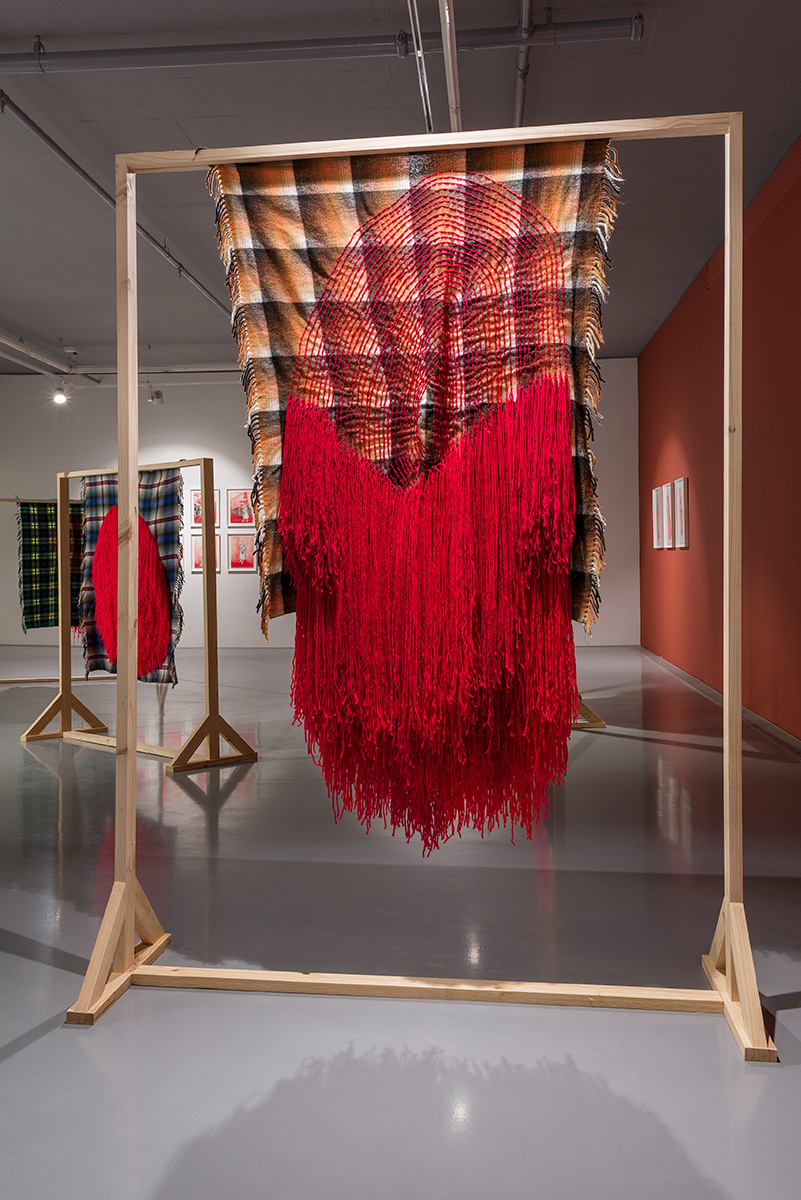
Senzeni Marasela (1977, South Africa) graduated from the University of the Witswatersrand in Johannesburg (1998) and shortly thereafter completed a residency at the South African National Gallery. Some of her career highlights include exhibitions at the South African Pavillion during the 56th Venice Biennale (2015), Zeitz Mocaa in Cape Town (2020) and the Museum of Modern Art in Paris (2021). Her work is represented in several collections such as Smithsonian Museum (USA), MoMA (USA) and Harry David Collection (GRE). She lives and works in Soweto.
During Art Rotterdam, Senzeni Marasela exhibits her art at Kalashnikovv Gallery from Johannesburg (Solo/Duo, booth 22).
Written by Pienk de Gaay Fortman
Adriano Amaral’s hybrid world
Those who missed the first solo exhibition of work by Brazilian artist Adriano Amaral at Galerie Fons Welters at the end of last year are in luck: Prole is being revived at Art Rotterdam. In part, that is. The gallery will be showcasing some of Amaral’s Prosthetic Paintings that were featured in Prole. For this series of paintings, Amaral used photographs taken with his smartphone as a starting point and then produced them in the same silicone as used for prosthetics.
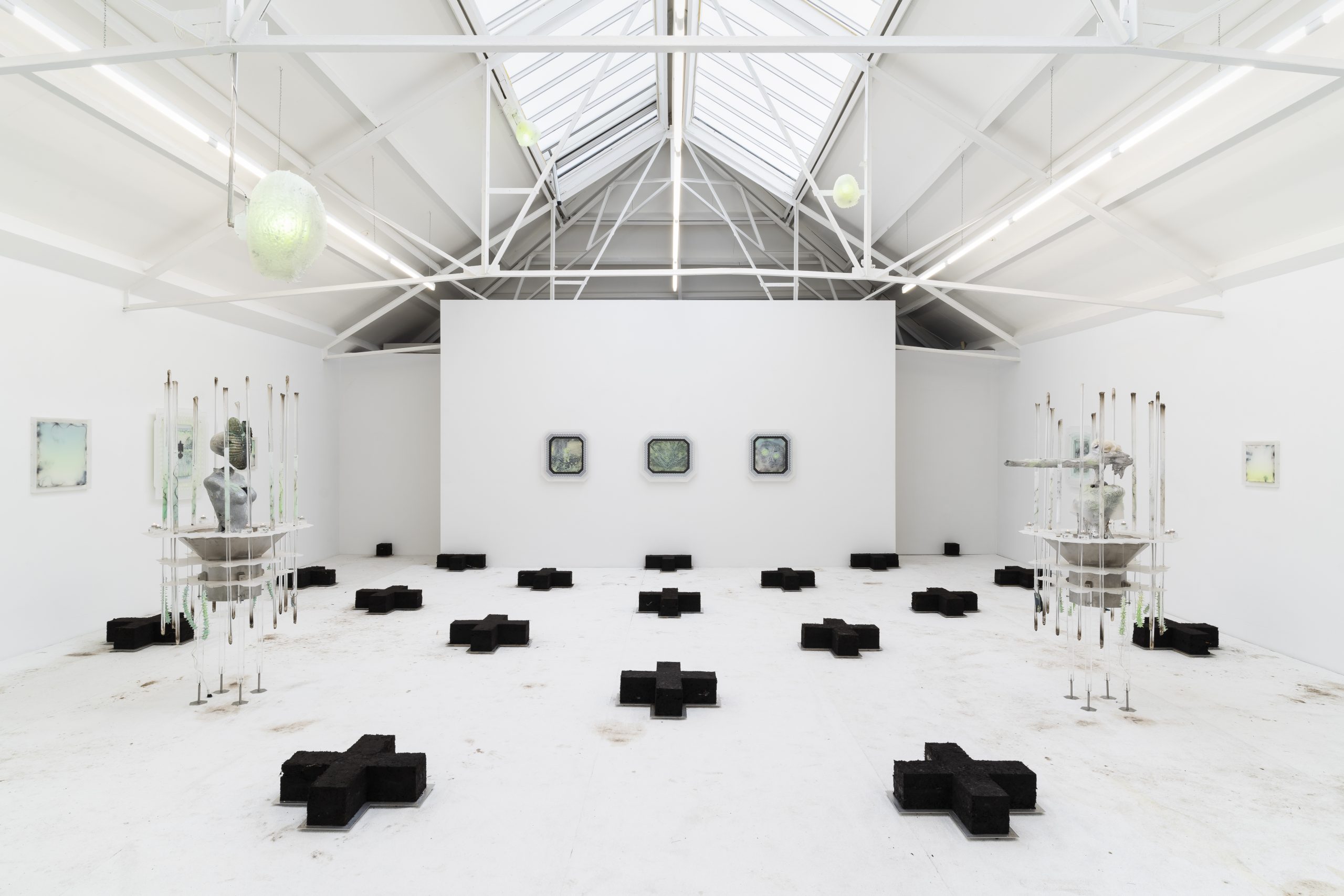
Describing the content of the work of this alumnus of De Ateliers is much more challenging than the type of silicone he uses. The press release for Prole, which means ‘offspring’ in Portuguese, describes Amaral’s work as an exploration of the materiality and content of everything surrounding us and how things gradually change over time. If we take the title literally, it is about over-evolved offspring. Amaral (Brazil, 1982) experiments with contrasts both conceptually and in terms of materials – living-dead, organic-digital, ecological-technological, but also tangible-ephemeral – to arrive at hybrid forms of those contrasts, which can be so confusing that you are forced to rethink the concepts.
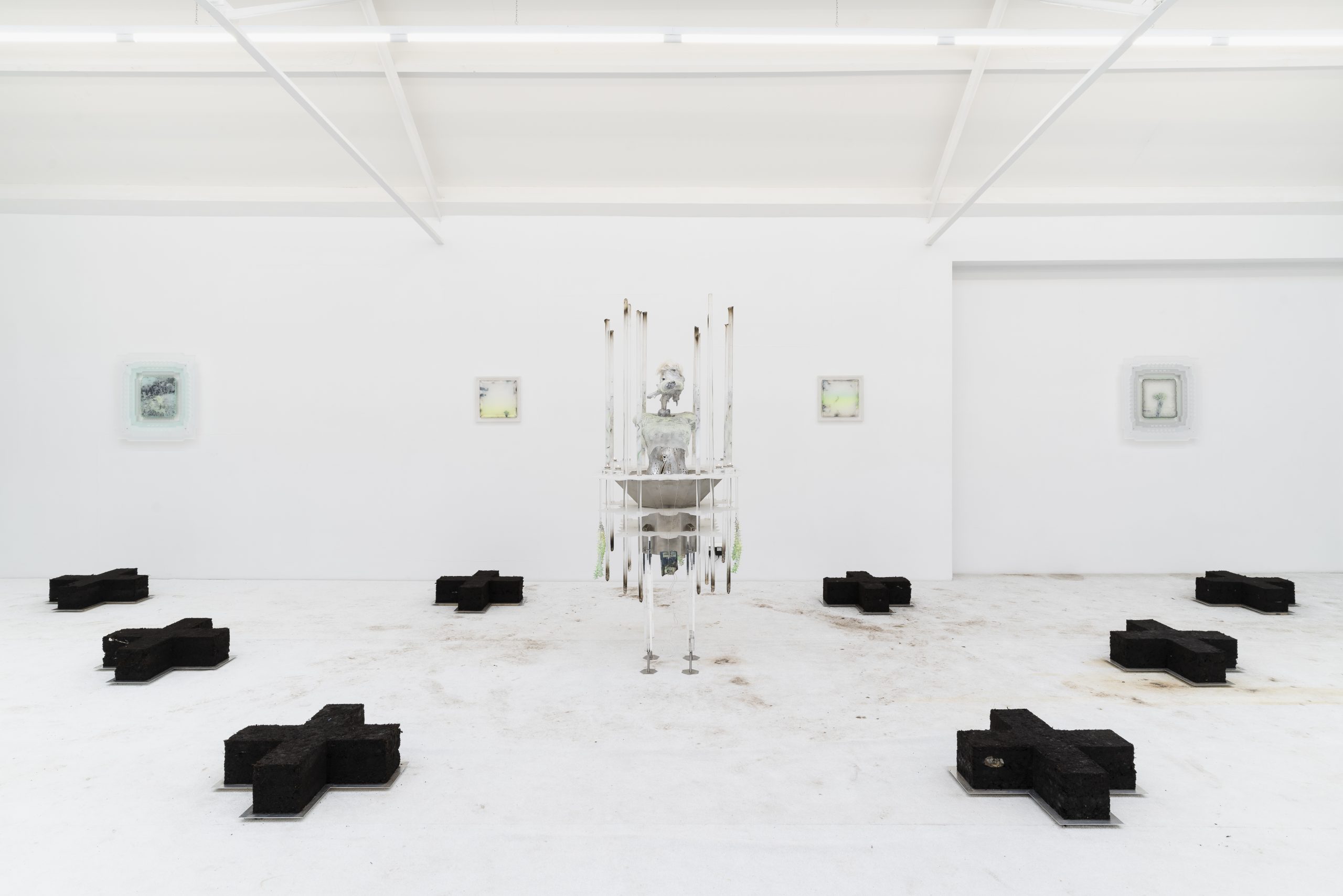
A space with its own logic
Those who came to see Prole had to step through a number of plastic flaps, as if entering a walk-in cooler, a symbolic gateway to a space with its own visual language and corresponding logic. On the floor of the entirely white gallery were 32 crosses made of dirt, each on its own aluminium platform. During the exhibition, the dirt continuously dried out, causing the crosses to become brittle and eventually fall apart.
The gradual transition from life to death is a fairly obvious contrast. The cross shape is a clearly religious symbol, combined with the slowly drying dirt, which may be interpreted as crumbling religious awareness, but Amaral takes it even further. The crosses extend all the way to the walls of the gallery, where half crosses are displayed. This creates the suggestion that the crosses continue endlessly outside the gallery, as if you’ve entered a kind of digital mesh where an organic and a digital world merge.
“My ultimate goal is a hybrid between something organic like dirt and the digital domain,” says Amaral, who worked on the installation for over a year. “At the beginning of my career, I mainly created site-specific installations, but nowadays also more autonomous work, like the Pinturas Protéticas (Prosthetic Paintings). But I still want visitors to see something everywhere and connect with other objects in the space. I also want my work to be open to interpretation so that visitors can make their own connections.”
Amaral describes his approach as intuitive. “Initially, I combined things I found, such as a branch with a cap from a PET bottle. Only after a few years did I realise that the things I combined carried a duality in them on many different levels. In a show like this, I start intuitively, but at a certain point, I know what I want to create and it becomes more conceptual.”
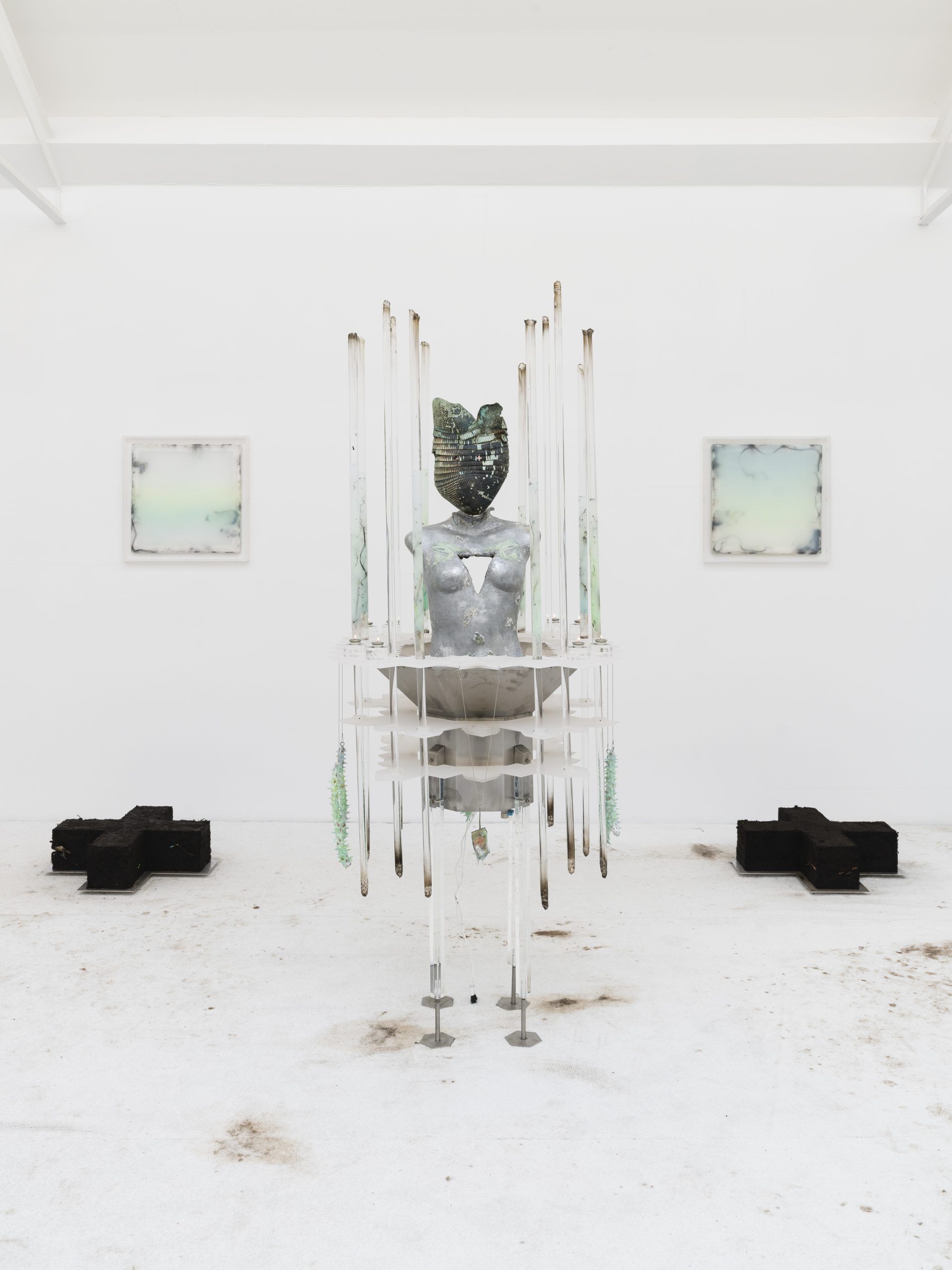
Pinturas Protéticas
On the walls hung the Pinturas Protéticas, made of silicone used in prosthetics for people who have lost a limb. Touching is rarely allowed in art, but with Amaral’s works the skin-like structure makes it difficult to suppress that tendency. “It feels soft, like human skin,” says Amaral. He has been working with silicone since 2015 but only developed this complex application last year.

With the Pinturas, there is also a hybrid aspect. Although the works have an almost skin-like quality, they were 3D printed. Because the works are recessed in a kind of membrane-like frame, you view them from closer by. For Amaral, it’s about the effect of experiencing something made with a printer as human and intimate. The depictions in turn have an artificial, futuristic citrus or lime green colour, making the animal scenes appear somewhat unnatural.
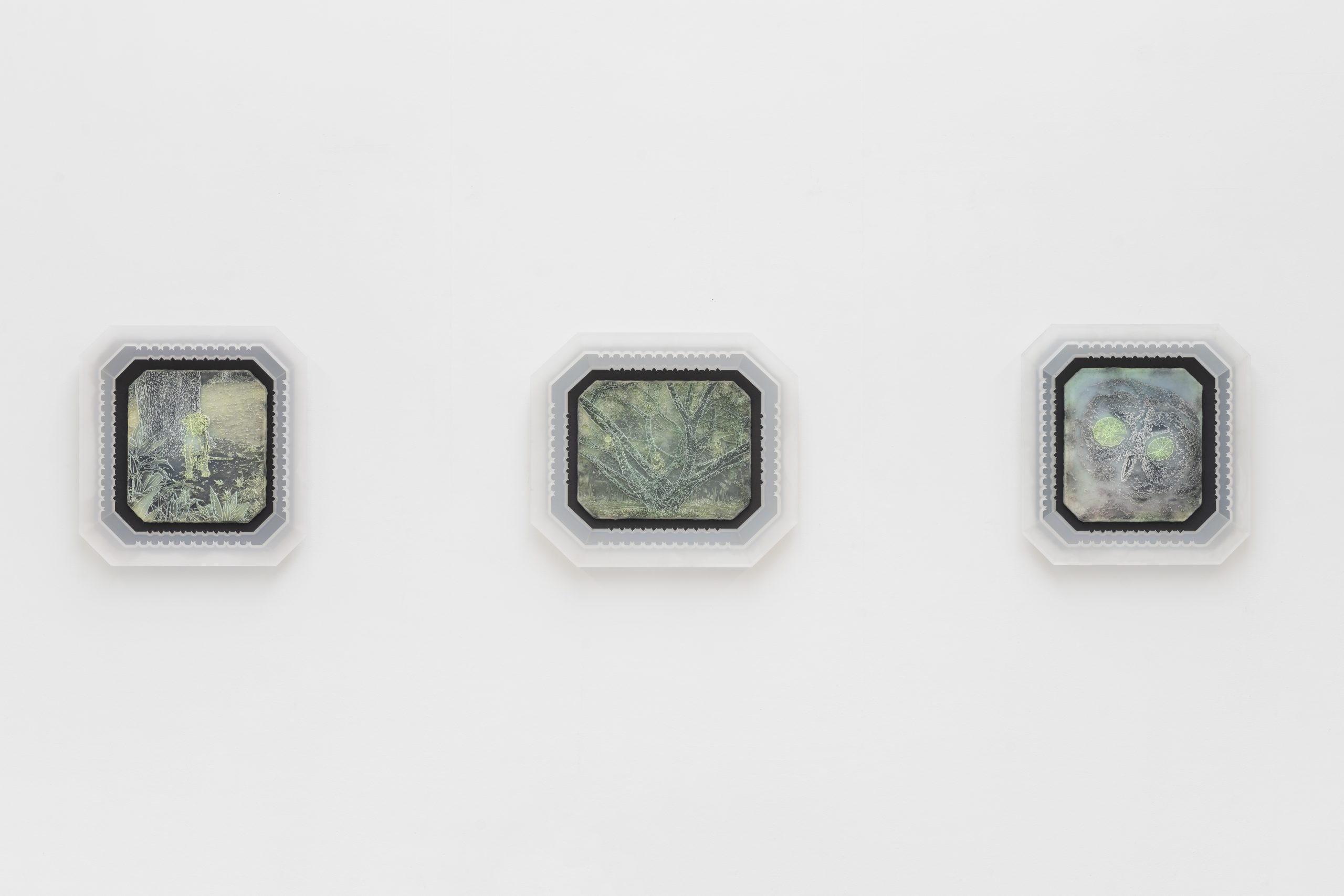
The photos that served as a starting point were taken by Amaral in his immediate surroundings with his mobile phone. “In past work, my environment was an integral part of the work in the form of the materials used,” says Amaral, who now lives on his family’s farm three hours from São Paulo. “This time, I also wanted to show images of my environment, so I’ve occasionally added something I like or found online, like the man in the frog suit.”
Written by Wouter van den Eijkel
For the eighth year in a row, the NN Art Award will be awarded to a promising artist who completed their studies at an art academy in the Netherlands and is exhibiting at Art Rotterdam. This year, for the first time, the nominees will exhibit their work in the prestigious Kunsthal Rotterdam, from 1 February to 14 April 2024. The nominated artists for the NN Art Award 2024 are Maaike Kramer (Art Gallery O-68), Mónica Mays (Prospects section of the Mondriaan Fund), Jan van der Pol (CREMAN & DE ROOIJ) and Peim van der Sloot (Brinkman & Bergsma).
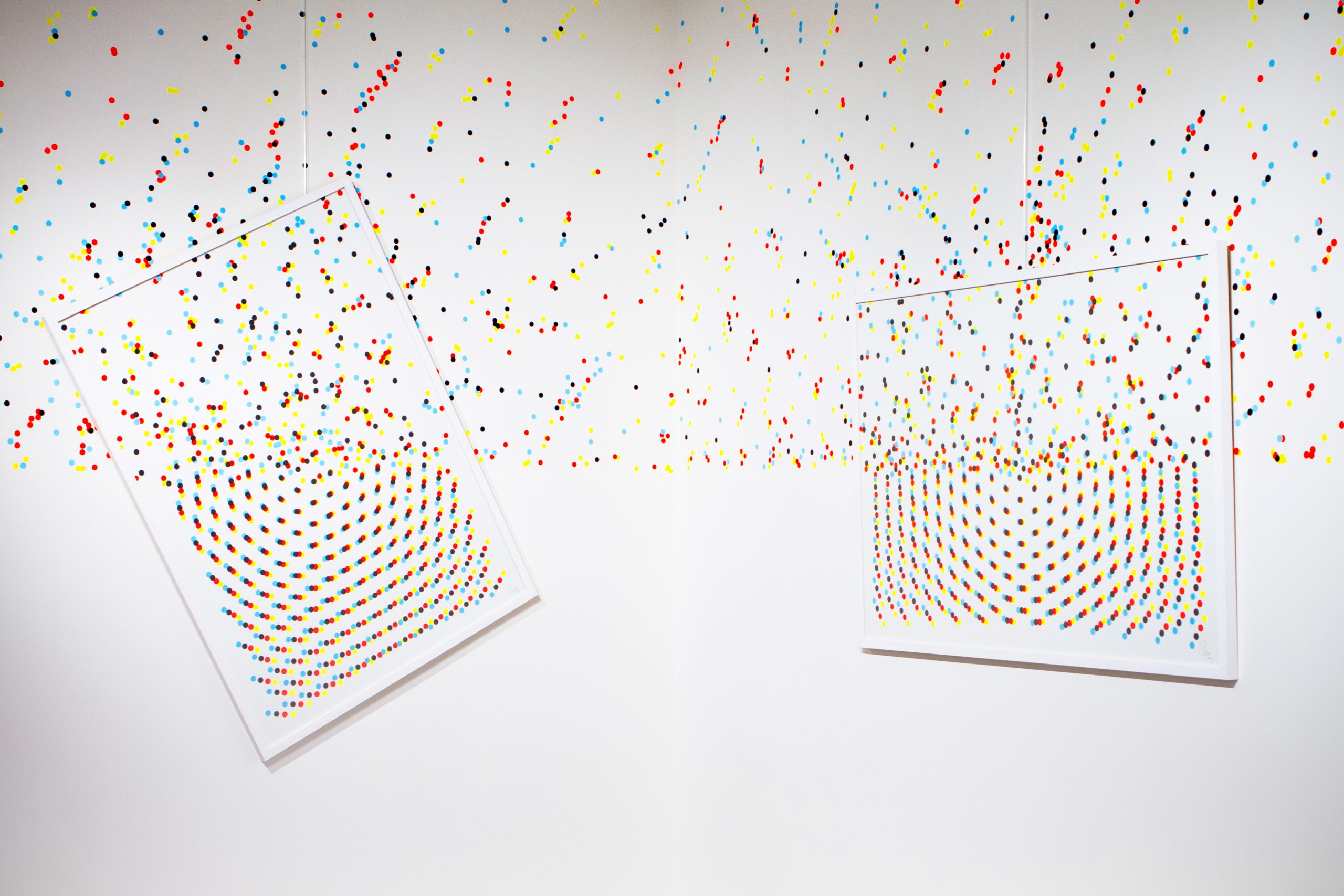
Peim van der Sloot’s abstract work is immediately captivating for its use of familiar round stickers: a familiar sight at art fairs, where they signify whether an artwork has been reserved or sold. In his practice, Van der Sloot critically examines economic systems. He questions concepts of value, scarcity and ownership, reflecting on the complex relationship between capitalism and the art world. The artist introduces alternative pricing systems and experiments with seriality, challenging conventional economic norms and assumptions, and inviting viewers to do the same. This questioning of the established order is also evident in his visual style, characterized by optical illusions, playful and dynamic compositions, vibrant colours, and a hint of chaos and anarchy. Van der Sloot grew up in Argentina and studied at HKU (University of the Arts Utrecht). His works are included in the collections of the LAM and the KPMG Art Collection and in 2021, he received the LAM Art Entrepreneur Award.

Can you tell us more about the work you are presenting at Art Rotterdam and in the Kunsthal?
“At Art Rotterdam, I will offer a diverse overview of my body of work to date. Starting with the conceptual approach to art sales, all the way to the latest works that are poised like magical incantations, ready to enchant the viewer. Some of the most prominent pieces I will display during the fair include ‘It Has To Start Somewhere’, a series consisting of 3479 pieces, each gradually missing a sticker that the buyer receives to stick next to the artwork on the wall, and ‘The Most Expensive Piece’, which will be the most expensive artwork for sale at Art Rotterdam 2024.
For the exhibition in the Kunsthal, I am creating a site-specific installation, in which I treat the museum walls as a canvas. In the work ‘Peim was here’, the red sold sticker will, of course, have a prominent place as well.”
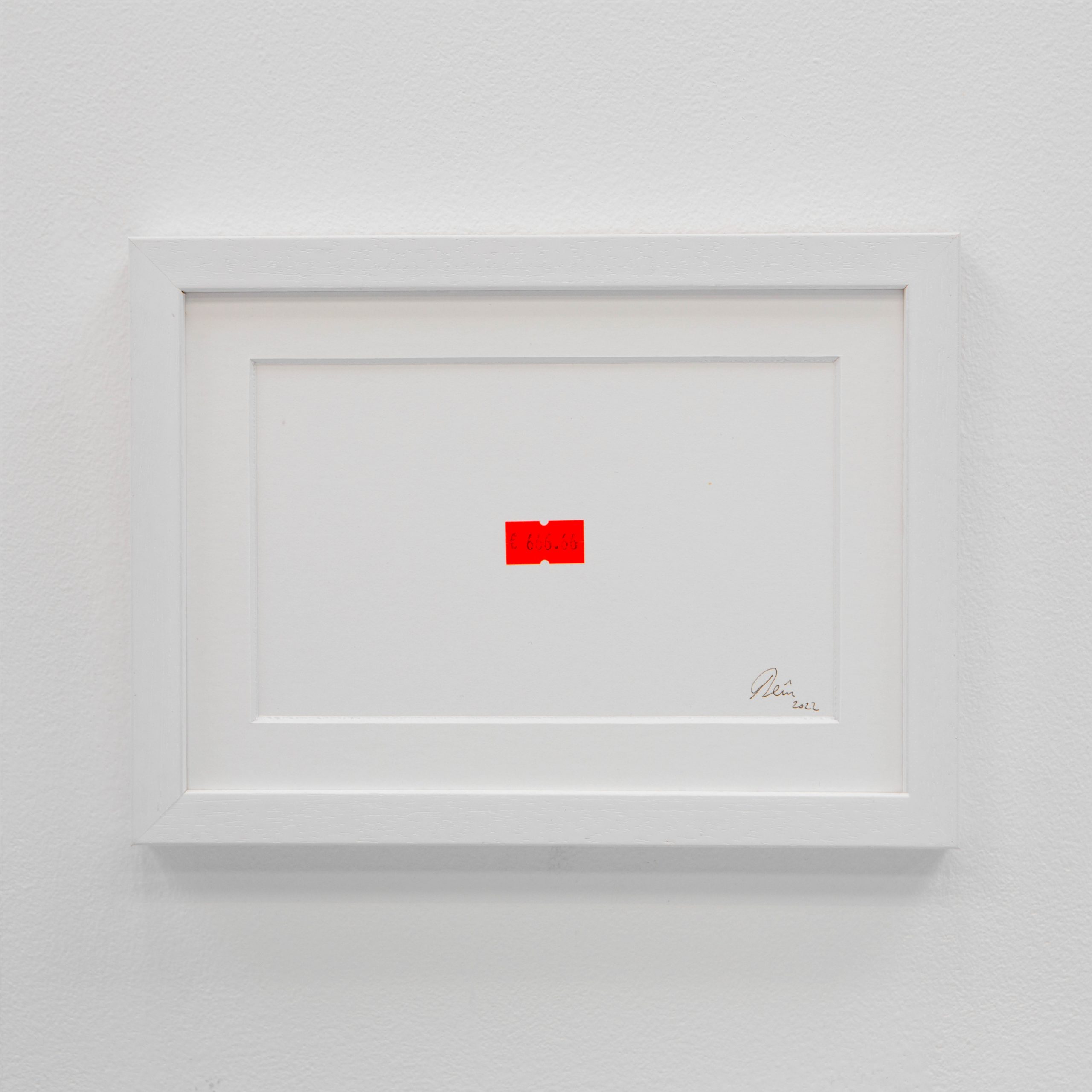
What are your plans for 2024?
“Besides ensuring that my work ‘Works I Have Sold In My Life So Far’ continues to grow, 2024 is going to be a year for experimenting with new materials and techniques. For instance, I want to dedicate time to explore the animation of my artworks in film format. I am also currently working on a collection of ‘digital artifacts’, artworks engraved on Bitcoin coins. It’s a bit of a technical story, but you can see it as putting digital graffiti on crypto currency. As long as two computers on earth are connected, these works will exist for eternity.”

Could you describe how you felt when you heard that you were nominated for the NN Art Award? What project would you start if you were to win the award?
“It was a very special feeling. I remember thinking: ‘the circle is complete’. In 2015, I won the ‘Keith Haring art-challenge’ at the Kunsthal, and subsequently made an artwork at Lowlands with the festival visitors. This was the start of my art practice. The opportunity to exhibit my work in the museum now, after all these years, holds added significance for me. I would also like to publish my own book, so perhaps I can realize that dream this year.”
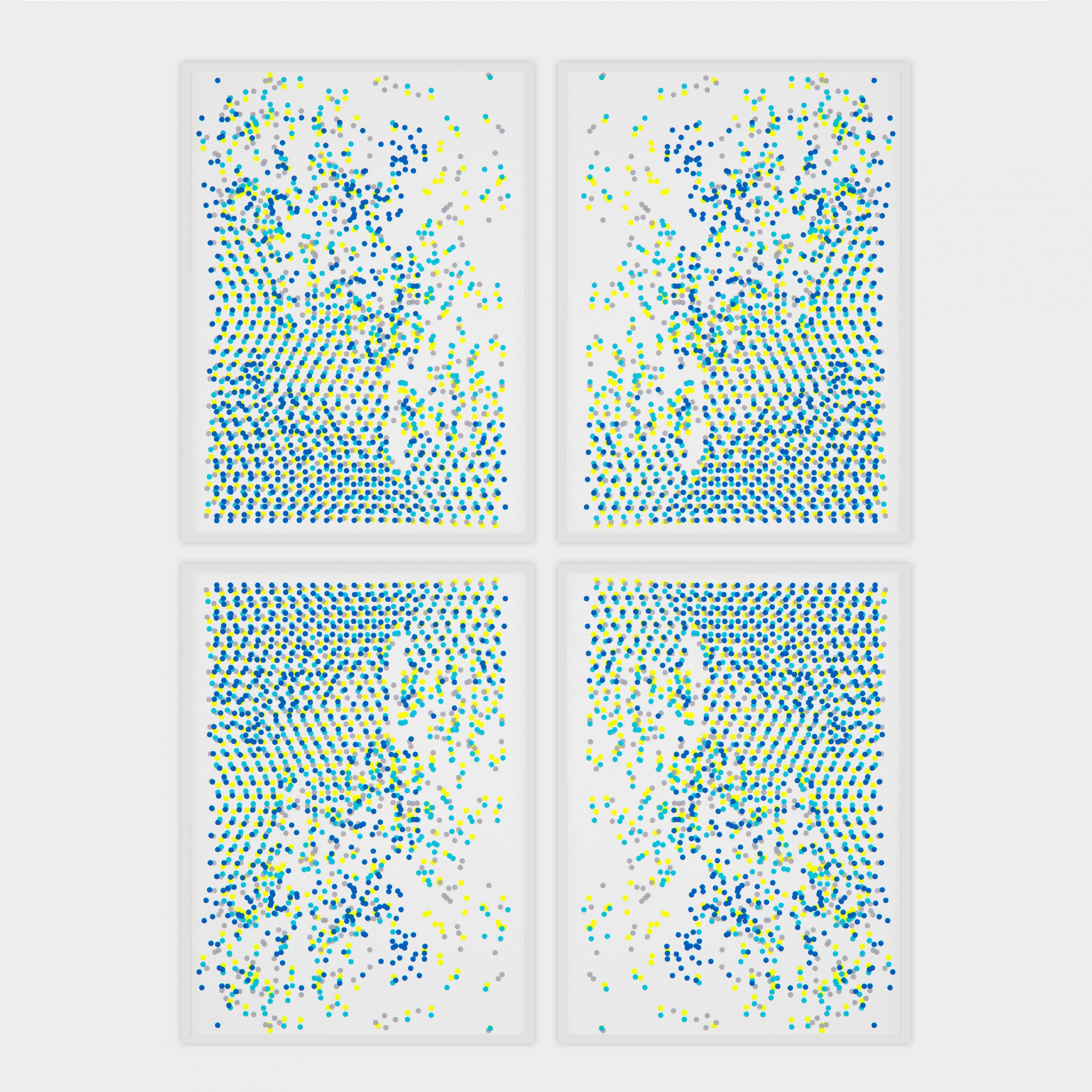
How do you view the role of economic systems in the contemporary art world? How do you try to find your own place in it?
“Art is often sold as an exclusive luxury product. The art market is full of written and unwritten rules. But what a work costs and what it’s actually worth are two different things for me. In my work, I engage with these rules in various ways — sometimes by disregarding them, at other times by adopting and then subverting them, or by approaching them with a sense of playful skepticism. In doing so, I aim to actively involve the buyer in contemplating these underlying questions. Money has become an abstract concept, while ideally, the sale of art is about human contact. Fortunately, I see more and more artists engaging with this, and I am very grateful that at my gallery Brinkman & Bergsma, I get the space to experiment with this.”

What is the best advice you’ve ever received?
“‘Do it yourself’ was the guiding principle when a group of friends and I formed a collective during our time at the art academy. We took the initiative to organize movie nights, create protest stickers, and set up exhibitions and festivals. With the collective power of a community, you can make anything possible. It also liberates us from reliance on established institutions and organizations. This led Marnix Postma and me to establish De Bouwput, an inclusive art space in Amsterdam that everyone can use. We embrace a non-selective, non-curatorial approach, pre-approving all proposals, embodying the concept of ‘Anarchy in a white cube’.”
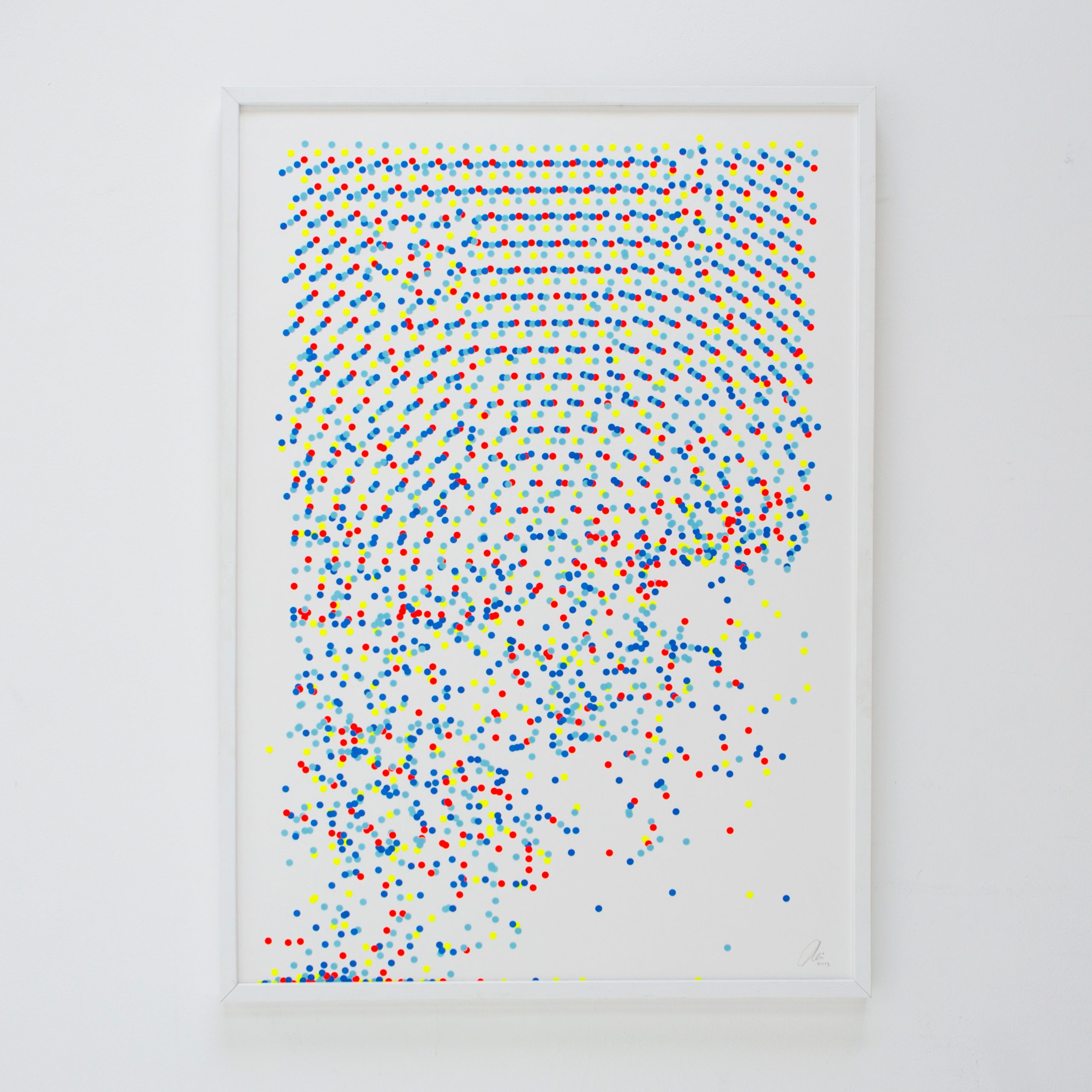
The winner of the NN Art Award will be announced in the Kunsthal Rotterdam on Thursday 1 February at 20:00 CET. The work of the nominees will be on display there until 14 April 2024. During Art Rotterdam, the work of Peim van der Sloot will also be shown in the booth of Brinkman & Bergsma.
By Flor Linckens
During Art Rotterdam, NN group will present the NN Art Award for the eighth time: to a contemporary art talent with an authentic visual language and an innovative approach. NN Group has been a partner of Art Rotterdam since 2017 and has been awarding an incentive award every year since then. An annually changing jury of art professionals makes a selection of four promising talents, from which a winner is ultimately chosen. The conditions are clear: it concerns artists who have been trained in the Netherlands and who show their work during Art Rotterdam. NN Group will purchase one or more works from the nominees for its corporate collection. Last year, the NN Art Award (worth €10,000) was awarded to Monali Meher, who is represented by Lumen Travo Gallery. Art Rotterdam interviewed her to find out what winning the prize has meant to her and what her best advice is for young artists. Read more about here work here.
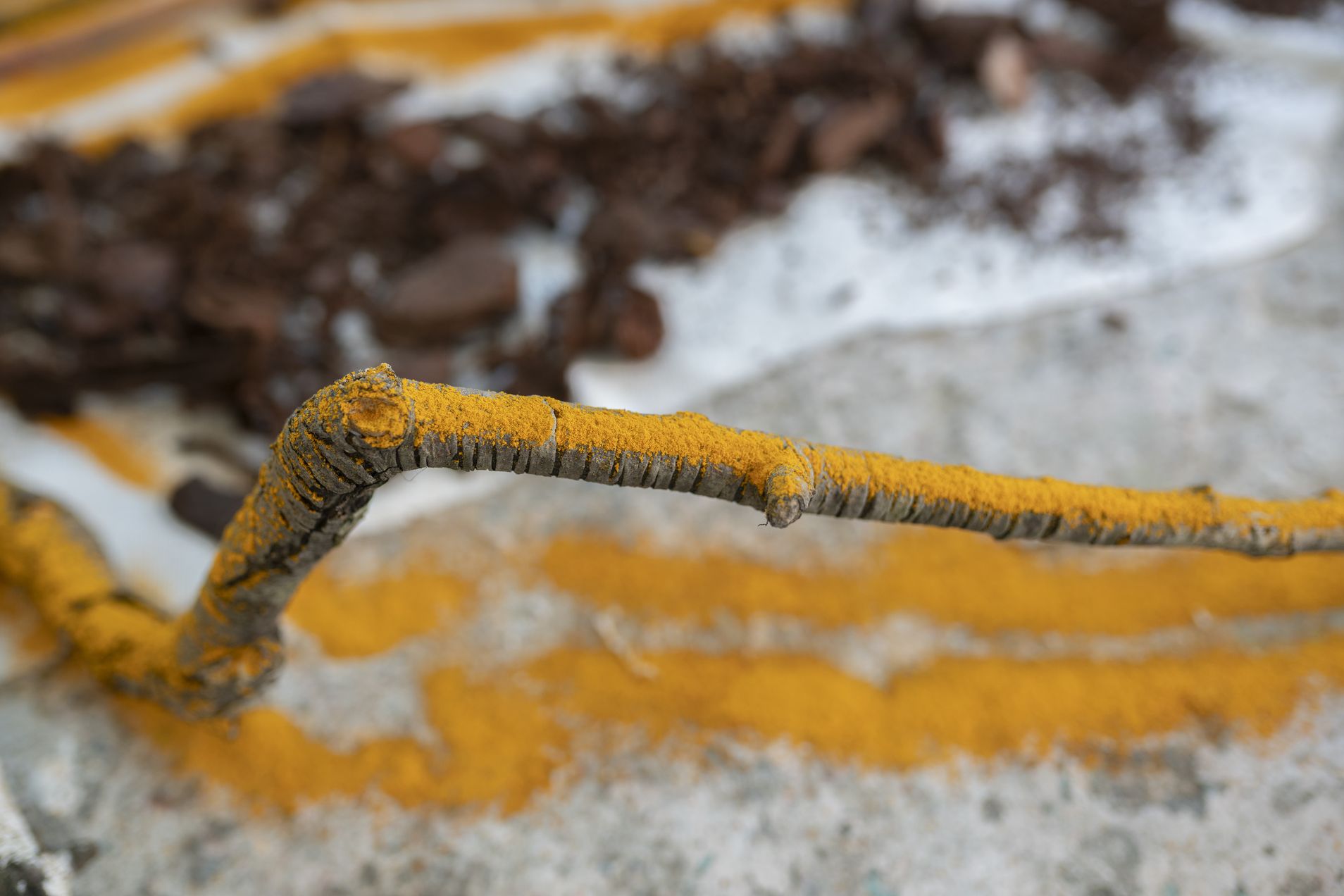
How did it feel to win the NN Art Award? Are there any particular things you were able to achieve thanks to the prize money?
“In December 2022, I had just arrived in Pune, India, visiting my mother and the family when I heard about the nomination. Marianne, my gallerist from Lumen Travo Gallery, called and gave me this fantastic news that I was one of the nominated artists for the NN Art Award. I was really happily surprised to hear the news amongst my family. It was a double joy! In the two following months, I settled with this news within me and felt very grateful and grounded. The actual announcement of winning the award at Art Rotterdam 2023 brought tears, not only to my eyes but to many who were present there. The tears of joy, wisdom, acknowledgment and freedom. I felt great honor, enthusiasm and gratitude. Since winning the award, I have been experimenting with new materials and processes. And I published my first book, ‘Unknown Landscape’ in October 2023. Of course, big thanks to the sponsors but also the prize money of the NN Art Award. It’s been greatly appreciated. You can find more information about the book on my social media.”
How did the works that you showed during Art Rotterdam come about? Do you follow a specific process? Has that process changed in any way since?
“The selected mixed media works (intricate drawings with black Japan ink and threads on digital photos) were from the time of pandemic, in the intense and unprecedented sequence of lockdowns the world has recently experienced. Through a new series of mixed media drawings and assemblages, I reflected on the pandemic period just gone by, highlighting the relentless cycle of ‘multiple beginnings’ we, as humans, are enduring in the hope to find a renewed and positive perspective for the world.
The other glass assemblages and recent new body of site-specific installation with soil, sand, hay, bark, coal, shells, dry plants, branches, turmeric, food colors, natural pigments, copper and glass has been developed since my residency at ‘Gent-Glas’, Ghent, Belgium in 2018/19 where I first time experimented with glass. But I could only create this site-specific installation, ’Unknown Landscape’ after the pandemic in 2022 in ‘Het Atelier’ residency in Brugge. Since then it has been continuously evolving. Then in a group show at Lumen Travo gallery, followed by Art Rotterdam 2023 and soon this site-specific installation will be viewed in the group show ‘NICC x 25’, at museum SMAK in Ghent. This exhibition was on view until 28 December 2023.”
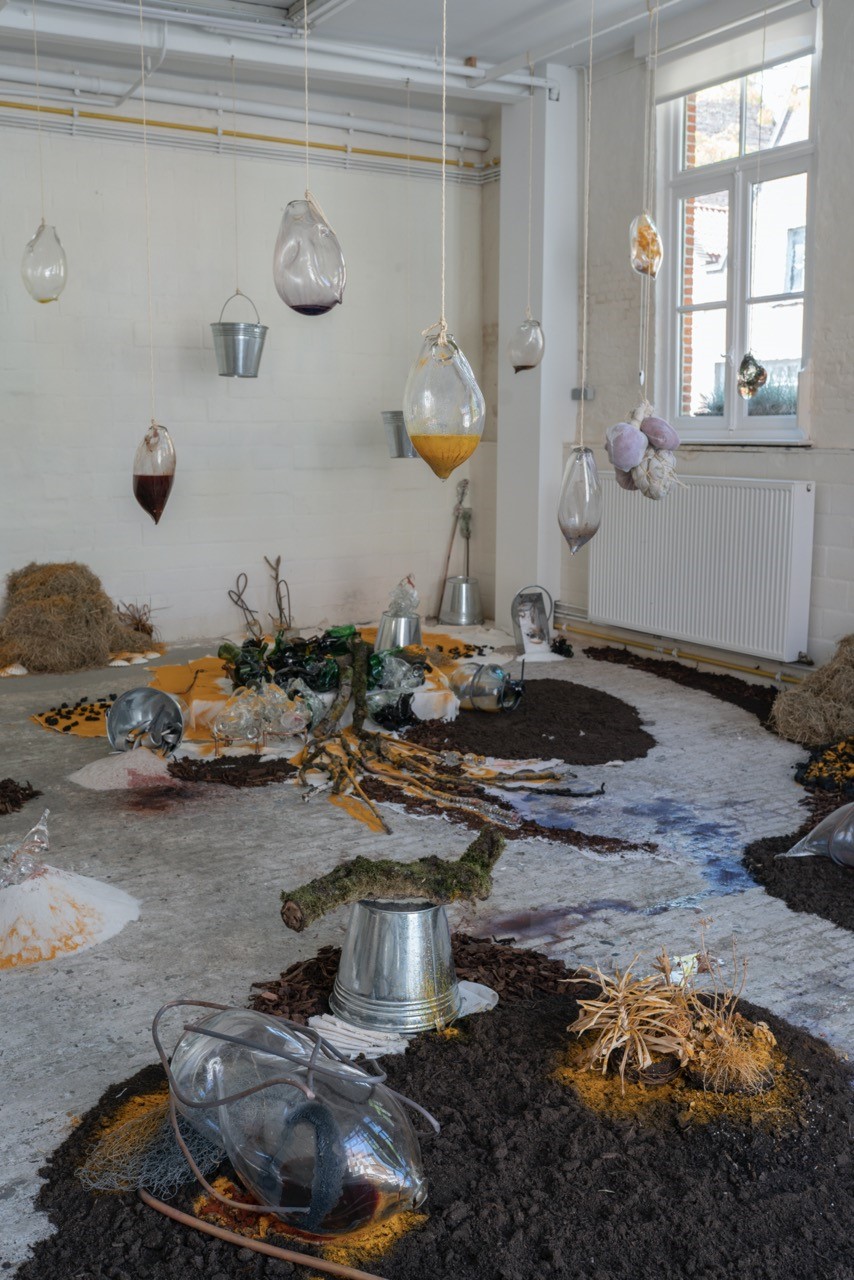
“My ongoing research-oriented installation ‘Unknown Landscape’ (2019-2023) contains several natural elements. They are combined together with the glass works created during the artist’s residency at Gent-Glas. The result is colorful & dynamic assemblage which is laid on the floor. Like the natural landscape, this installation is alive, evolving silently but persistently. The materiality of the soil, pigmented fluids and other unique textural properties of the landscape emerge in each aspect of the installation. This hybrid installation is a sort of spread out terrain of various combined components and blended elements. I juxtapose the materials from my earlier body of works with new recycled glass objects, to create a new/ transformed identity by re-shaping, re-arranging, re-cycling, re- assembling various materials, that keep the process of transition growing in the space. This diversified, surreal installation of solid, fluid, cracked, repaired, fragile structures of melted glass forms, that serve as a multi-layered ambiguous landscape, an immersive, extended, breathing field to interact, to observe and to explore the changes it went through. This hypnogogic installation explores the geological observation of nature’s traces, its ruins, mutating landscapes and the survival of holding onto what’s left to protect.
‘Unknown Landscape’ stimulates questions about sustainability, identity, migration, boarders, barriers, loss, and the endless cycle of exploitation of natural resources. At the same time, paradoxically, this installation takes us through organic, peaceful and healing trail that is interventive & interactive where people can walk through to approach different areas of the installation closely and observe details. The smell of natural materials as well as the aroma of strong yellow turmeric spice punctuates the exhibition space.”
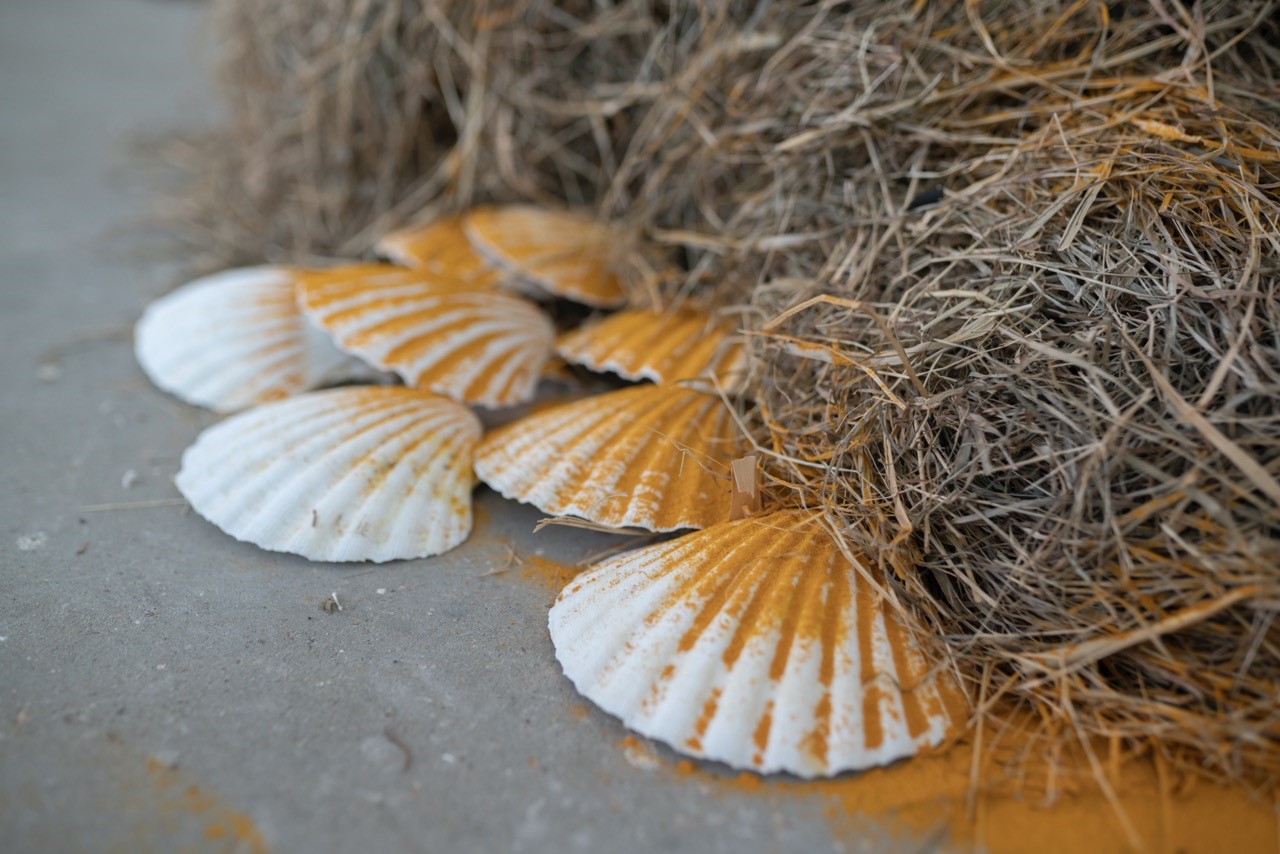
Do you have any specific rituals or routines that you follow to stay creative?
“I think ‘creativity’ or ‘being creative’ lies in every aspect of our life, our surroundings and daily life rituals and its nature. For example, when cooking I don’t follow a standard recipe but my own way of mixing a combination of spices. There is no such thing as ‘the best creative routine’. It is a journey of self-discovery, following your instinct, taking risks and being open to changes. It is necessary to have a specific rhythm, balance and discipline in life, forming our own routine or ritual. We are human beings and we all lose it once in a while but to bring back that balance is being creative too.”
As the winner of the previous edition, you get to join the jury for this year’s edition. What is it like as an artist to ‘judge’ the work of other artists?
“Every process is an interesting and learning journey. I would say it is more like ‘reviewing’ the works of artists than ‘judging’. It is about carefully seeing, discussing and observing with other juries who are part of this process. To experience the ‘other side’ or ‘back stage’ is important in life.”
What is your ultimate piece of advice for young artists?
“Follow your heart, keep the balance! Stay focused, curious, true to yourself and to your creativity. Persistence and discipline are important. There is no beginning or end to this creative journey. It’s about life and death and everything in between.”
By Flor Linckens
For the eighth year in a row, the NN Art Award will be awarded to a promising artist who completed their studies at an art academy in the Netherlands and is exhibiting at Art Rotterdam. This year, for the first time, the nominees will exhibit their work in the prestigious Kunsthal Rotterdam, from 1 February to 14 April 2024. The nominated artists for the NN Art Award 2024 are Maaike Kramer (Art Gallery O-68), Mónica Mays (Prospects section of the Mondriaan Fund), Jan van der Pol (CREMAN & DE ROOIJ) and Peim van der Sloot (Brinkman & Bergsma).

Mays’ sculptural practice combines autobiography, material process and historical archive. Her pieces are composed of assemblages taking the shape of animated domestic objects that are spilling over, distorted or in a process of transmutation. Drawing from catholic body horror and baroque iconography she has been working with excess, ornamentation and exuberance. From the depiction of maladie and magical thinking in female figurines, to colonial representations of nature, dominance, desire and control, the baroque is deployed by Mays to create works that exist in a tension of fragility and violence.
After having studied Cultural Anthropology at the University of New Orleans, she graduated from the École Supérieure des Arts Décoratifs in Strasbourg in 2015 and received an MA from the Sandberg Instituut in Amsterdam in 2017. She has developed projects in artistic residencies such as Rupert (Vilnius, Lithuania), Fundación Bilbao Arte (Bilbao, Spain), Matadero (Madrid, Spain) and Cemeti Institut for Art and Society (Yogyakarta, Indonesia). Mays’ works have been exhibited in spaces including the Frascati Theater (Amsterdam), Tallinn Art Hall (Tallinn), Punt WG (Amsterdam), Blue Velvet Projects (Zurich), Centro Centro (Madrid), KUBUS (Hannover), La Casa Encendida (Madrid), Industra (Brno) and Atelier Chiffonier (Dijon). She has been awarded the 3PD prize bestowed by the Amsterdam Fund for the Arts 2022, the Mondriaan Fund Young Artist Stipendium 2023 and the Generation 2022 prize from the Montemadrid Foundation.
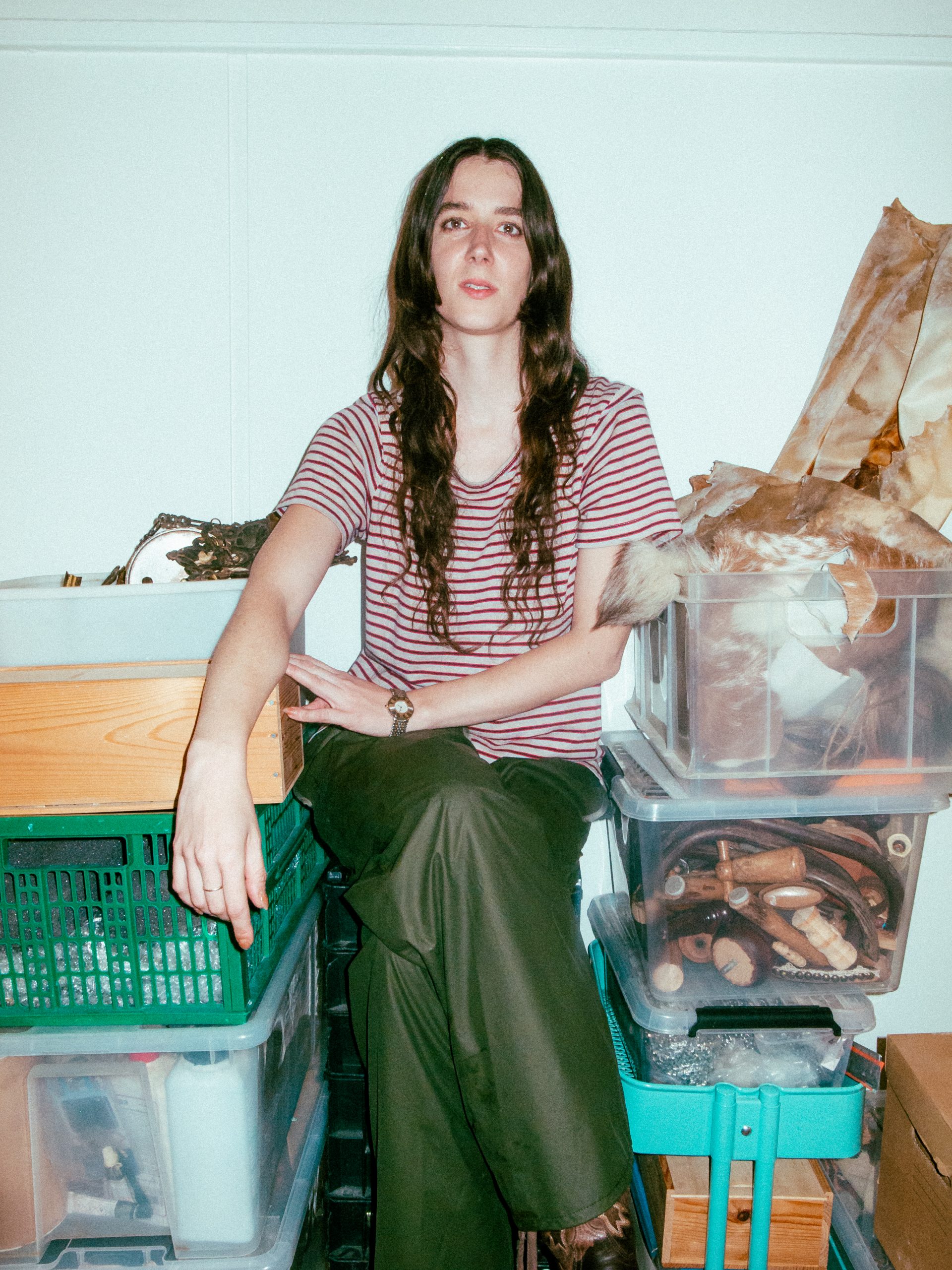
Could you tell us a bit more about the work you are presenting at Art Rotterdam and in the Kunsthal?
“I present a series of sculptures and boxes that I’ve been working on over the past two years. With these pieces, I aimed to cultivate and explore forms of reproduction that might sit outside of patriarchal structures, industrial means of production, efficiency and futurity, and the violence that these logics impose on different bodies. I’ve been exploring these ideas through a close engagement with the life cycle of the bombyx mori silk moth — an organic reproductive process that has been irrevocably altered by human intervention, domestication and industrialisation. In order to fully extract a silk thread for use in textiles, silk moth cocoons must be steamed to kill the grub inside before it can hatch and break through the single line of silk it used to create its cocoon. Those moths that are allowed to hatch do so only to breed and die shortly after; thousands of years of production-oriented domestication have rendered the moth blind, albino and flightless, with a vestigial mouth that cannot feed. The silk moth cocoon, for me, contains a multitude of semiotic and biological meanings — both those of extractive violence, biopower and heteropessimism, but also the potential for the breaking of linear logics, the refusal of reproduction, and the embracing of mutation.
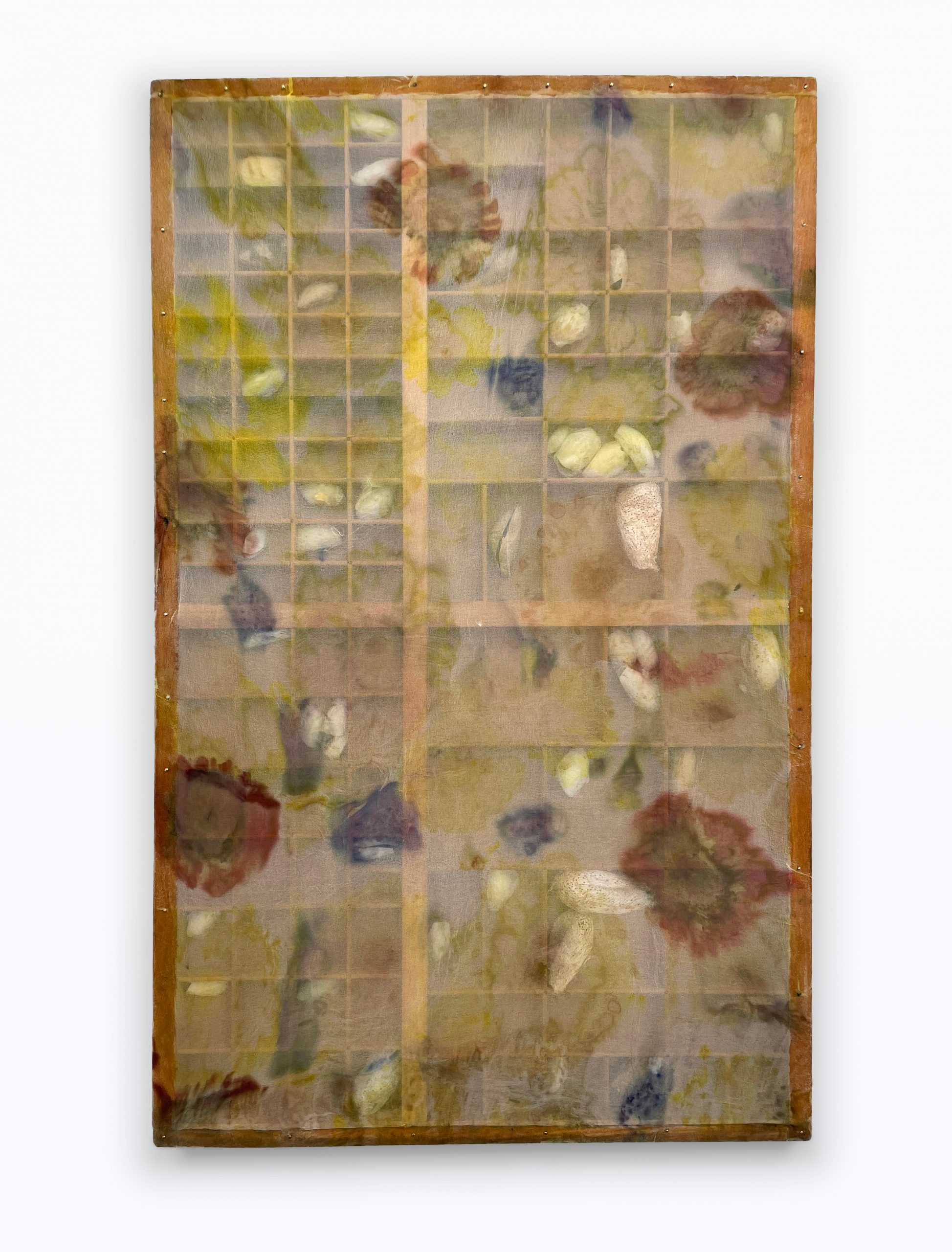
Last year I cultivated the bombyx mori, accompanying them through them their reproductive cycle, allowing them to all hatch, and working with them and their products towards a series of assemblages, collages and sculptures. These assemblages are composed of a combination of found anachronistic domestic objects that are interrupted by the excess of other bodies: wool, feathers, vellum, cocoons come together to make a body out of bodies. In addition I present “Shadow Boxes”, wooden gridded objects that are employed for scientific categorization, division and taxonomical separation in the drawers of archives and museums. Discarded ones are often used by individuals for collecting small memorabilia, appropriating the grid as a subjective and personal mechanism. In a similar way, I have been collaborating with the bombix mori and their products to parasite the boxes, preserving their cocoons intact by covering the boxes with silk and botanical imprints that interfere with the grid’s structure.”
What are your plans for 2024?
“In March, I will be going on a three month residency at the Cemeti Institute for Art and Society in Yogyakarta with the support of the Mondriaan Fund, where I will be continuing a project I recently started at the Mediterranean coast of Spain. Throughout my projects I lean on certain examples as containers of both violence and fragility. In this case, I have been looking at the iconography and symbolism of the palm plant through its paradisiac, biblical and industrial imaginaries. The project began by looking at the ornamental function of the plant to gentrify coastlines in Southern Europe in contrast with its exploitation in other regions, Indonesia being one of the largest producers of this plant for the fabrication of palm oil. I am considering palm oil as an ubiquitous material, present in almost all of our bodies through our consumables, and drawing a parallelism with the religious concept of omnipresence often used in biblical depictions of palm plants. So far this has materialized through a series of clay pieces fired with the combustion of palm leaves and creating assemblages with found factory objects. I don’t really know how this will continue to materialize as I feel quite in the middle of the process, but throughout the year I will be presenting some of the pieces in Art Basel, in Arco Madrid and in several galleries in New York, Basque Country and Bucharest for example.”
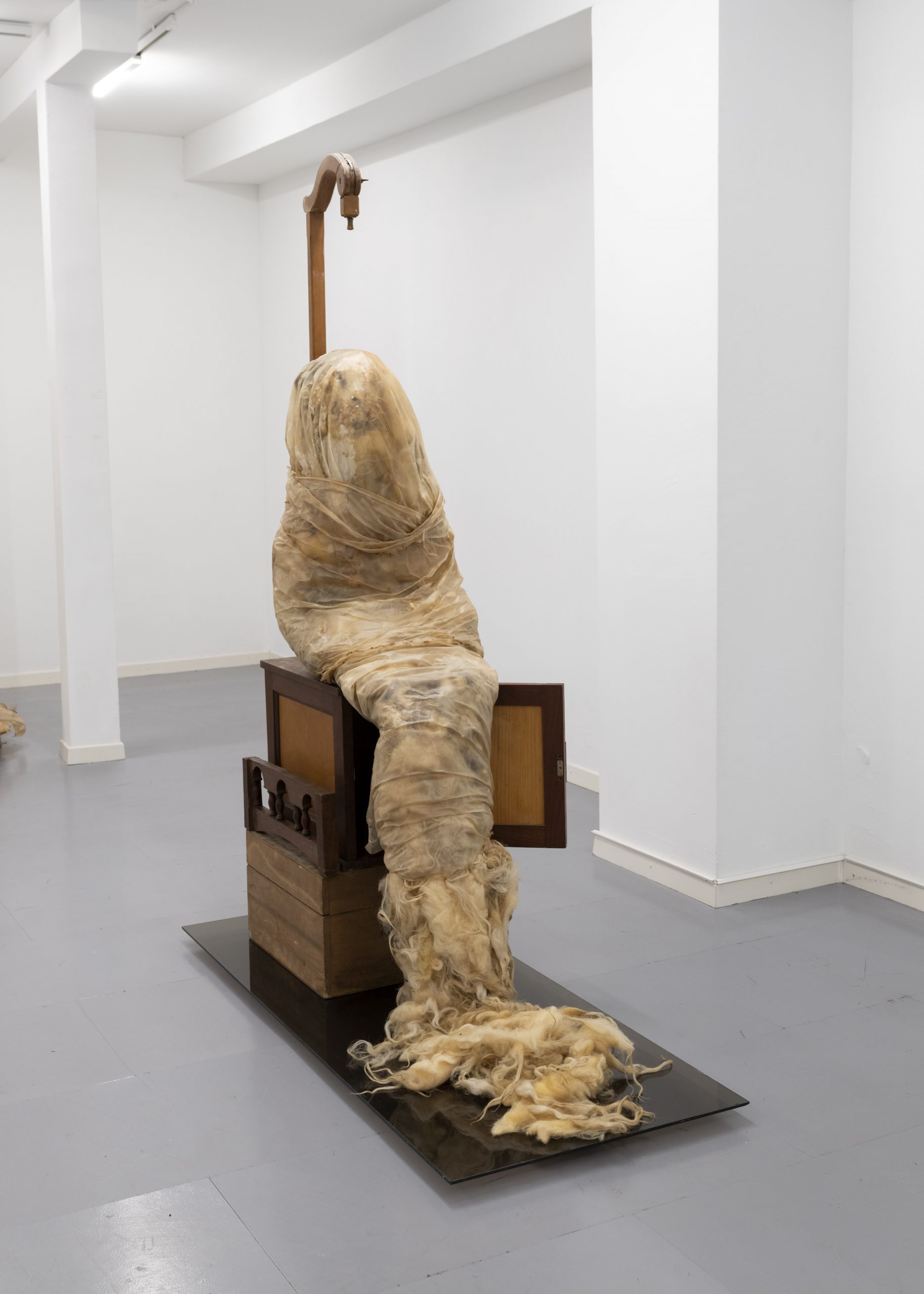
Could you describe how you felt when you heard that you were nominated for the NN Art Award?
“I was very happy of course. It is a really nice feeling when the work comes across and is recognized amongst so many of the beautiful projects that a lot of my colleagues and peers are presenting at Prospects. I have been living in Amsterdam for eight years, making work in all sorts of studios throughout the city, but it has always been quite hard to present the work locally, partially because of the lack of spaces, but also because of a lack of visibility. I have mostly had invitations to present work abroad so for me, this is a really nice opportunity to share my work with the context that has helped me incubate most of my works.”
What project would you immediately tackle if you were to win the award?
“There are always more projects to work on. If I was to receive the award I would like to make a work that is no longer at the scale of my own body, that is not so conditioned by practicality. When I talk about my pieces, I often say that they are animated domestic objects because I imagine them moving, opening, closing, extending their arms, but in the end their forms are static. I think I would use the opportunity to engage with the necessary engineering requirements to make them performative. Maybe, but it feels very uncertain, I would finally make the film about a specific crying statue that I have been talking about for five years now.”

How would you explain your work to someone who might not be as well-versed in the art world? What should their most important take-away be?
“It is my hope that the pieces I make don’t need a very eloquent verbal explanation and that they can narratively or affectively communicate themselves. Most of the work is process, materials and forms coming together in the studio, which is actually the hardest part to talk about. I can always tell stories, give analogies, introduce some of my chaotic referential framework, but ultimately, I would like them to not need a well-versed explanation and to speak autonomously through eroticism, tactility and tension.”
What is the most rewarding compliment you have ever received about your work?
“That it moves somebody.”
The winner of the NN Art Award will be announced in the Kunsthal Rotterdam on Thursday 1 February at 20:00 CET. The work of the nominees will be on display there until 14 April 2024. During Art Rotterdam, Mónica Mays’ work will also be exhibited at the Prospects section of the Mondriaan Fund.
Written by Flor Linckens
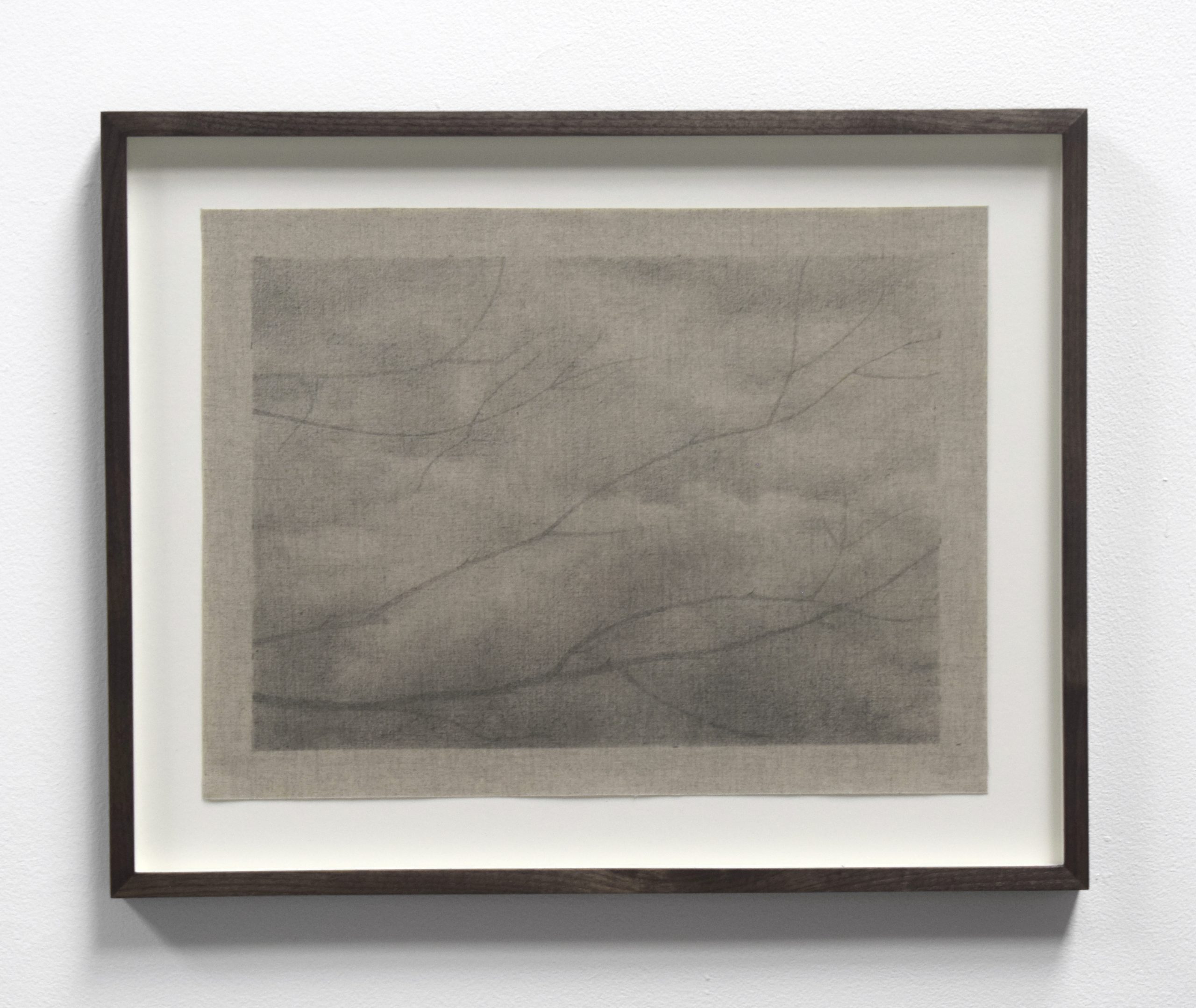
Pipeline from London will present a series of new works by Callum Harvey in the New Art Section at Art Rotterdam.
This British artist has a keen interest in transitional environments. His practice straddles the line between the natural and the constructed, drawing inspiration from architectural details and repeated ornamental patterns, both the extraordinary and the mundane. In his work, he delves into spatial environments, raising questions about how we construct, perceive, and utilize spaces. What role do botanical motifs and symbols of nature play in this context?
Harvey’s paintings are characterized by flowing, organic forms and repeated patterns, often magnified in scale and flattened in character. He employs a soft colour palette of natural and pastel hues, applying paint in transparent, thin layers. This technique gives his paintings a ‘backlit glow’, a background radiance that appears both artificial and natural. This juxtaposition of the artificial and organic is a recurring theme in his work.
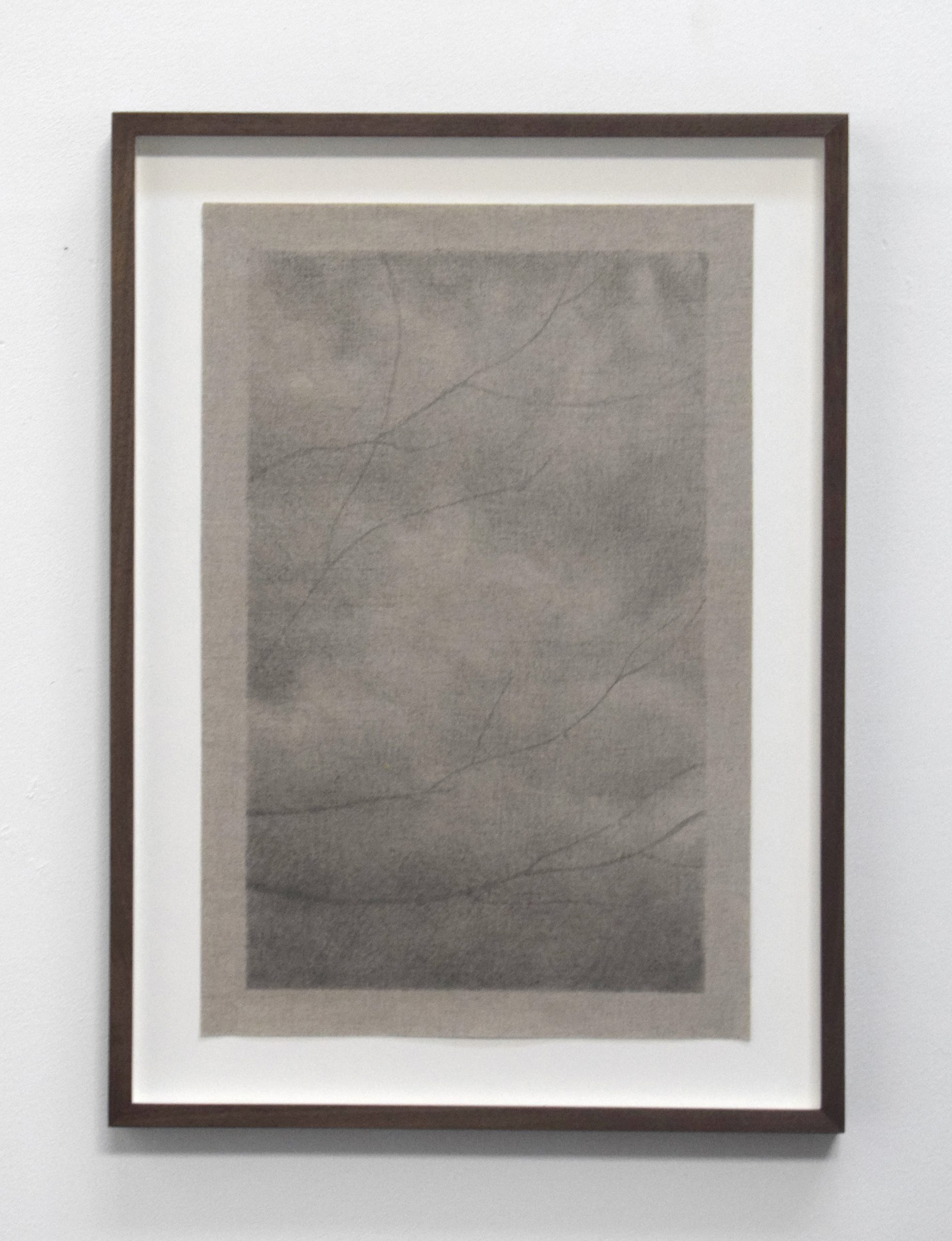
Nature serves as a significant source of inspiration for the artist, including decorative motifs from Art Nouveau and the British Arts and Crafts movements — a series of artistic and social movements from the late 19th and early 20th centuries that advocated for a revaluation of handcrafts and traditional crafts as a form of resistance against industrial mass production. Harvey reflects on the social history and ideas behind these decorative elements and their relevance to our contemporary life, as well as the status and class they often represent. Moreover, Art Nouveau and the Arts and Crafts movements present idealized depictions of nature, forming an intriguing subject of study for Harvey: how are these elements designed, and how do they enable us to experience nature and spaces in new ways?
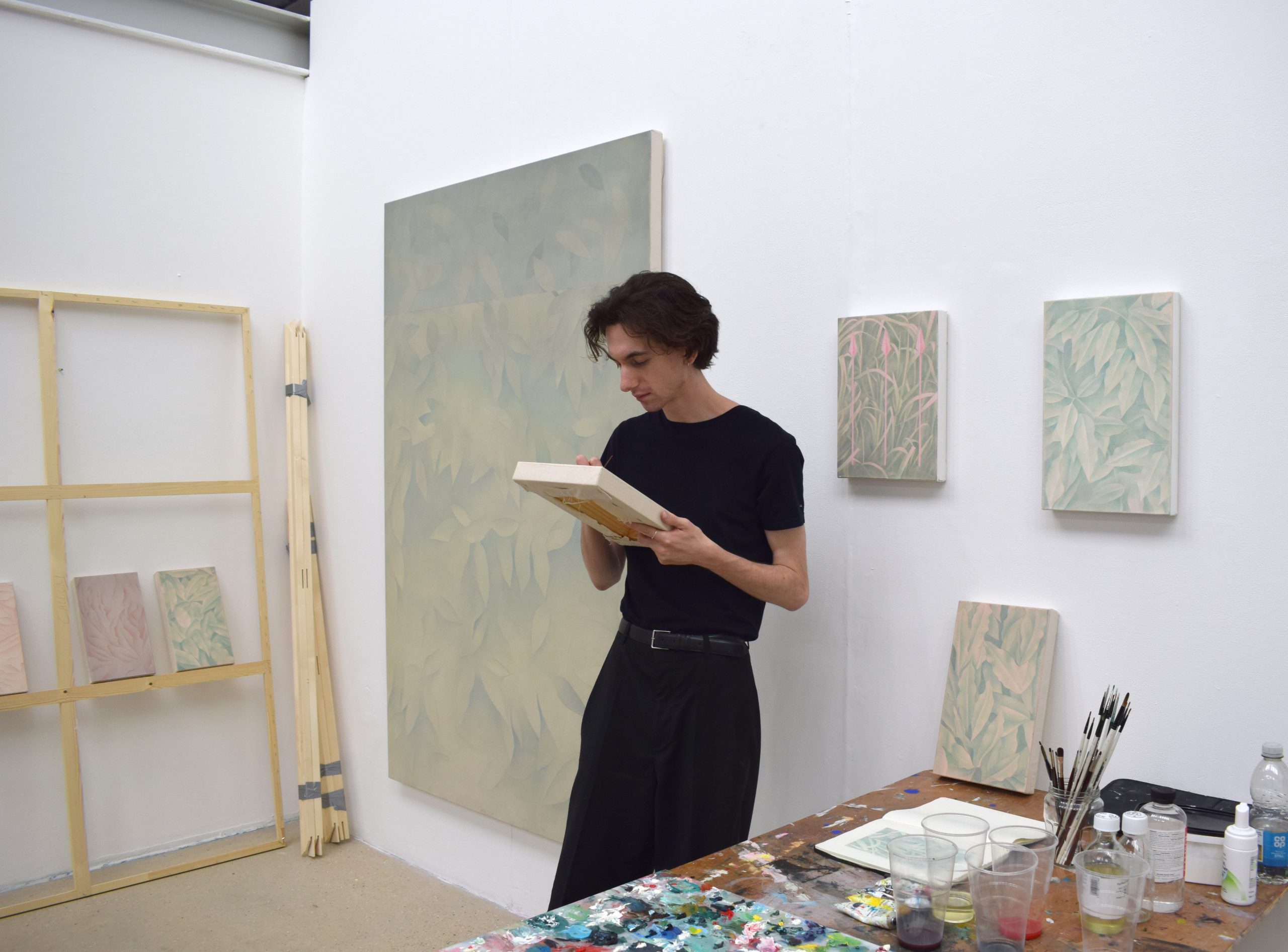
For Art Rotterdam, Harvey engages with a unique artificial space: a fair booth. He’ll present two large paintings with flattened portrayals that were stripped of spatial depth, alongside four smaller works in carved wooden frames, effectively integrating domestic and design elements. The paintings contain interior motifs that are common in wallpaper, contrasting with the space in which they are displayed.
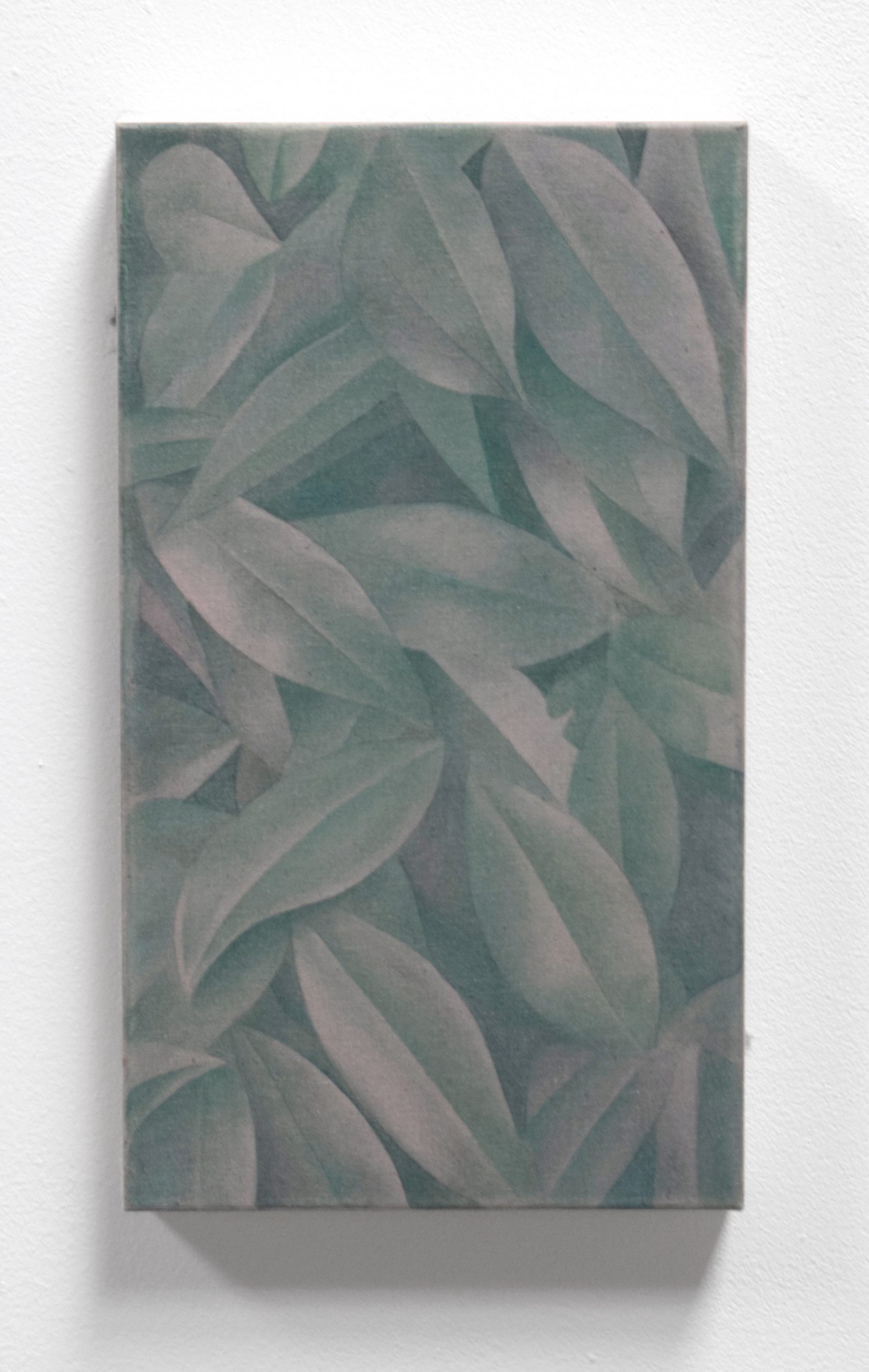
Callum Harvey was born in 1998 and lives and works in London. He studied Fine Arts at Falmouth University, followed by a master’s degree at The Royal College of Art, where he graduated in 2023. He has received multiple scholarships and awards, including the Radcliffe Trust Craft Scholarship in 2022, and completed a residency program at Porthmeor Studios in St Ives in 2019. Last fall, his work was featured in a solo exhibition at Pipeline and his work was also showcased in Kingsgate Project Space and Safehouse in London, Centre Space Gallery in Bristol, and Huxley-Parlour in New York.
During Art Rotterdam, Callum Harvey’s work will be on display in the New Art Section, presented by Pipeline.
Written by Flor Linckens
Art is often displayed and experienced in a similar context: the distinctive white walls of a gallery or museum. The iconic Van Nelle Factory, part of the UNESCO World Heritage List, already stands out from this traditional white cube concept due to its unique architectural character. Moreover, the fair offers an additional way to experience art: outdoors. Around this historic building, more than 20 (often large-scale) artworks are exhibited during Art Rotterdam. Free from the confines of walls, these works become part of their environment and gain new meanings in the process.
Atelier Van Lieshout (presented by Galerie Ron Mandos)
Atelier Van Lieshout is known for its multidisciplinary practice that straddles the boundaries of art, design, and architecture. Joep van Lieshout often uses industrial materials to explore socio-critical and provocative themes. At Art Rotterdam, he presents the work “Vulture” (2022). Vultures are as imposing as they are repulsive. Death is near when this scavenger arrives. However, vultures are also resourceful, persistent and an indispensable link in many ecosystems. According to Van Lieshout, artists are comparable to vultures. They devour everything that might serve as inspiration, old and new, and are viewed with suspicion. Van Lieshout would have preferred to see collectors viewed as vultures: as they hungrily circle vulnerable art. Van Lieshout’s works have been featured at the biennials of Gwangju, Venice, and São Paulo and are part of the collections of Fondation Prada, FNAC, Museum Boijmans Van Beuningen and the Stedelijk Museum.
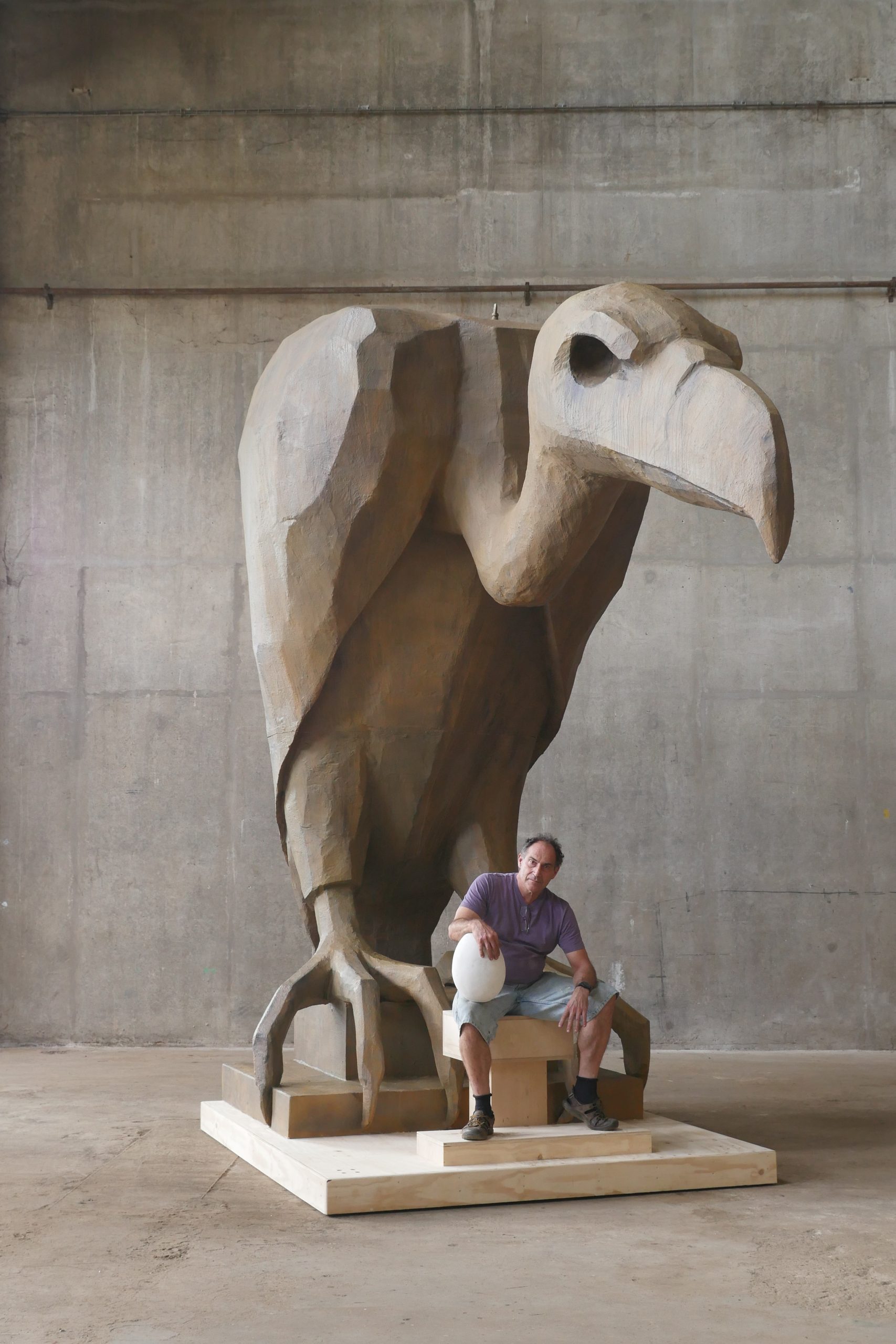
Baoyang Zhao (presented by Josilda da Conceição Gallery)In Baoyang Zhao’s work, intangible phenomena often take on a tangible charge. A scent, or a memory. The artist graduated from the HKU last summer and will present the work “The Trace of a Ghost Walking along the River” (2023-2024). How can you not wet your shoes when you walk along the river? This project talks about the bodily pleasure with the absence of the body. The artist explore the topic under the context of their experience as non-binary person. The liminality of their body aligns with the key experience with pleasure which dwells only on the border of land and water, indulgence and restriction. We hear the whisper of the pleasure under the water meanwhile we know the land is where we can stand on. We wet our shoes. We linger and we walk along the river. But what will be wet when a ghost floating along the river? What will be left in he bodily pleasure when the body is missing?
Jonas Dehnen (presented by Pizza Gallery)
With the work “Pterion shelter, oder die dünnste Stelle des Schädels” (2023), Jonas Dehnen plays with the genre of the sculptural garden folly. A folly, in architecture, is a primarily decorative garden building, which through its appearance suggests a fictional history (for example a fake ruined castle or grotto). Dehnen’s work can be read as a sculptural proposal for a dilettante park folly in the shape of a tin-foil hat, a homemade protective device, and a symbol of paranoia and conspiratorial thinking. It expands on the visual language of the artist’s paintings and drawings, which for several years have integrated themes such as the painterly landscape, maps of historical garden designs, automata, and hermitages. These undergo a subjective examination led by the (im-)possibilities and the ‘cultural memory’ of the material. The sculpture is partly made of the plates used to print the book.
Joeri Woudstra (presented by Nest)
As the February sun traces its short arch over Rotterdam, sounds of Joeri Woudstra’s work will echo over the terrain of the Van Nelle Factory. Woudstra, a multidisciplinary visual artist and composer, presents work from his series “Radiate” during Art Rotterdam. For this giant cross made of speakers, Woudstra mixed echoes, samples, and loops from pop music with iPhone recordings and live performances recorded during sunsets.
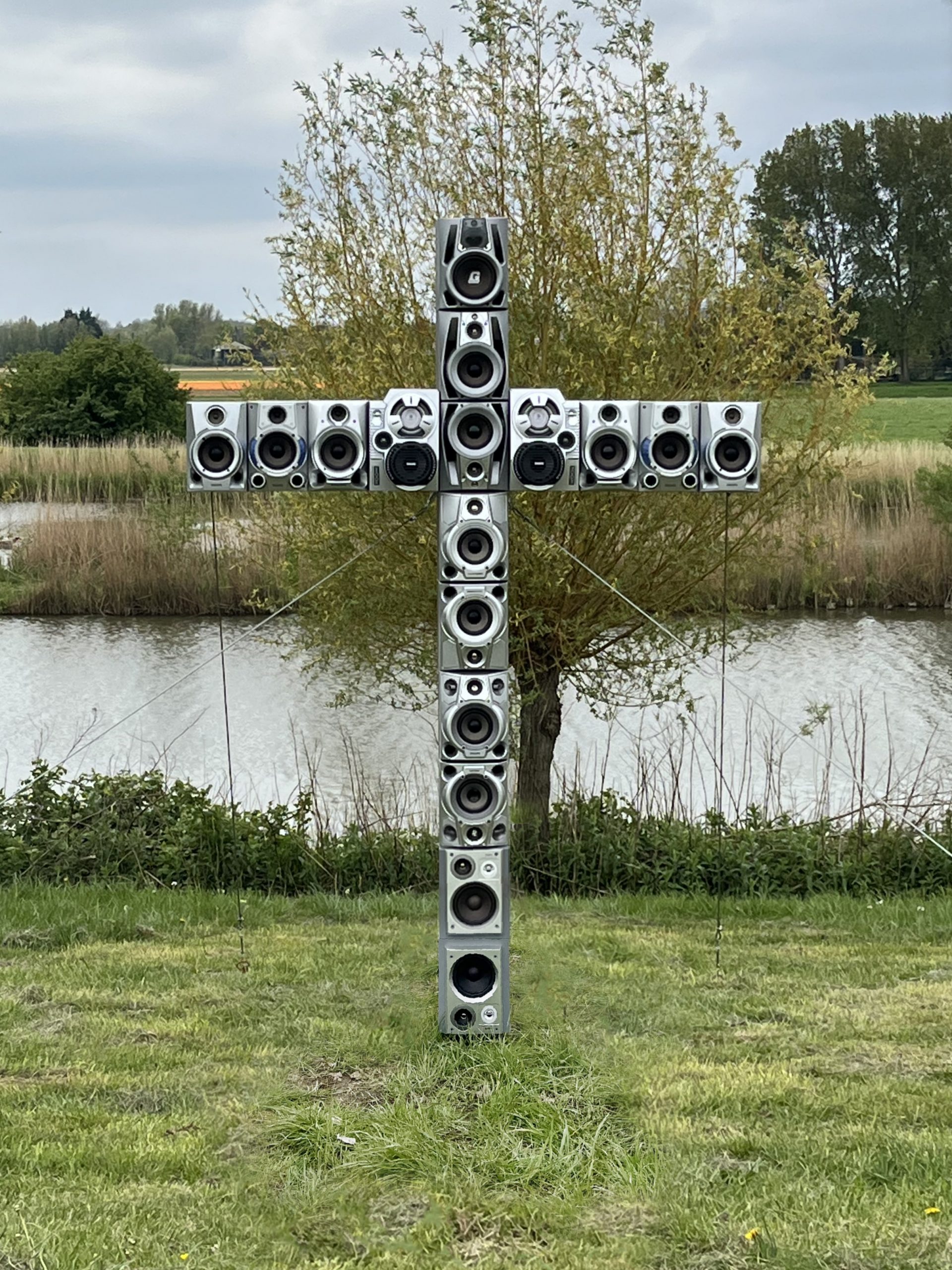
Karin Kytökangas (part of the Prospects exhibition organised by the Mondriaan Fund)
“I wish the world were softer,” Karin Kytökangas (1991) confesses. With paintings and sculptures executed in a dreamlike visual language, the artist challenges painful power structures. She is especially interested in the tension between power on the one hand and vulnerability on the other. In order to depict this tension she uses the contrasts between soft and hard. The vulnerable, soft medium of painting, for instance, can simultaneously be hard when using a powerful visual language or making a strong substantive statement. The sculpture “The Long Haul” (2023), standing outside the Van Nelle Factory, is literally a soft object that is now hard: a fixated white flag eternally billowing in the wind. For the artist, this work is about a desire for peace. By creating contrasts between shape and content, Kytökangas encourages us to surrender to reality and argues in favour of innovation.
Dré Wapenaar (presented by NL=US Gallery)
The oeuvre of the Dutch sculptor Dré Wapenaar is closely linked to architecture. Monumental tent constructions are a recurring form in his practice, often as a reaction to the urban space. His ecological works often have a very specific purpose and offer space for the human dimension. For example, he designed a tent for sellers of street newspapers and tents that involve death and birth. How do people use the public space and does that space reflect those same people? Wapenaar hopes to start a dialogue between citizens and their city. During Art Rotterdam, he presents “TENTVILLAGE REVISITED” (2007), a microcosm of society. Wapenaar says: “You can see this work as my proposal for urbanization.”
Oscar Peters (presented by C.o.C.A.)
Oscar Peters predominantly creates large-scale kinetic sculptures. In his latest works, he explores encompassing themes such as loss, grief and fury. At Art Rotterdam, he exhibits “The Gift of Fury” (2024), in which he investigates collective grief, joy and the need for hope in the face of contemporary alienation. This is achieved by integrating elements from other cultures and rituals, as well as cinematic traditions of world building. Like walking into an alternate universe, the installation evokes strong feelings, like those inspired by the romantic, almost sentimental depictions in pre-raphaelite paintings of death, loss, grief, and mourning. Fury, born from these emotions, is not necessarily blind anger but rather a directed or guided rage, with a potent goal, either to destroy or create. Upon entering the work, you are no longer just an observer, but a participant in the creation of the ritual; stepping into a shared place of mourning, a contributor to collective healing. The Collectors of Contemporary Art (C.o.C.A.) foundation consists of a group of eight collectors of contemporary art, united with the goal of supporting the work of young, promising artists in the Netherlands by providing an annual grant.

Marcel Mrejen (part of the Prospects exhibition organised by the Mondriaan Fund)
Greenhouse cultivation enables new landscapes to exist within established ones, as a greenhouse set up in the polder, for instance, can accommodate a different climate for growing crops. Marcel Mrejen (1994) collected greenhouse sounds, such as the buzzing and droning of ventilators, pumps, and neon lights. He then fed hours of these audio recordings to an artificial intelligence that transformed them into a soundscape. Placed outside the Van Nelle Factory, the installation “Cottagecore (Paradise Haunts Growth)” (2022) is playing this soundscape with the help of nine speakers. The artist is no longer in control of what the installation allows the public to hear, while its duration is undetermined as well. Apart from being a spatial entity, the sculpture thus also extends over a period of time. Occasionally, the installation produces the sound of a voice. According to Mrejen this is the algorithm’s consciousness contemplating the costs of growth: How can we use technology to restore non-exploitative relationships with the planet?
Geraldo Dos Santos (presented by Josilda da Conceição Gallery)
Geraldo Dos Santos, known for his affinity for narrative complexities, introduces “La Santeria de Mama” (2023-2024) as a profound endeavor in cultural decolonization. By centering on the symbolic significance of candles, meticulously deconstructs hierarchical systems associated with the persuasion of these ritual objects. This prompts thought-provoking inquiries about the multi-emigrated identity. “La Santeria de Mama” manifests as an installation of stories, with each candle representing a chapter in the ongoing narrative of cultural resilience. Specifically chosen for their tenacious spirit, the candles transform into a powerful metaphor symbolizing the enduring strength of cultural identities from Latin America. This hegemonic phenomenon transcends conventional art boundaries, acting as a catalyst for a parafiction. The vibrant colours of the sculptures disrupt monochromatic narratives, creating space for nuanced perspectives. Uncomfortable truths embedded in migration narratives are exposed as preconceived notions are dismantled, prompting a collective reexamination of societal structures that perpetuate hierarchies based on origin and heritage.
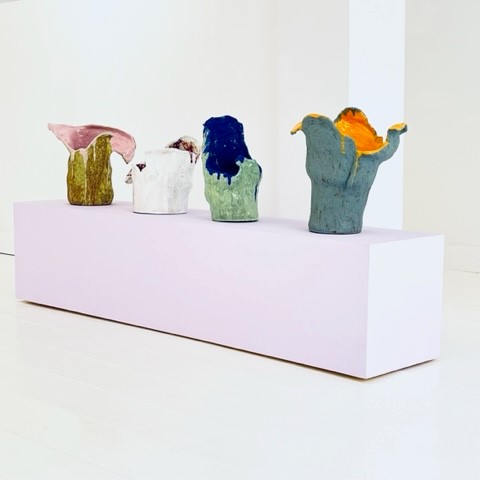
Adriaan Rees (presented by Livingstone Gallery)
High in the air, at over 4 meters, stands a striking lilac sculpture on a metal pole. The polyester figure is a woman bent over with a bucket in her hands. Her head, covered with long hair, is largely hidden in the bucket. The title of the work, “Screaming in a Bucket” (2023/2024), is evocative and originates from a dream. At their booth on the fair floor, Livingstone Gallery will present a special edition of this work in porcelain with silver. Rees, known for his versatility in materials, splits his time between Amsterdam and his own studio in Jingdezhen, China. He creates sculptures and installations and works on large-scale projects, performances, and sculptures for public spaces.
John M. Robinson (presented by A Modest Show)
British artist John M. Robinson is known for his performance paintings. During tarot readings and other occult or spiritual events, the artist embodies new personas, which become the documented paintings. At Art Rotterdam, Robinson will perform in a modest garden shed outside the Van Nelle Factory, adorned with images and equipped with spy holes. At scheduled times, he will perform a number of durational works there.
Marieke Bolhuis (presented by NQ Gallery)
Marieke Bolhuis exhibits an installation of three sculptures: “Starting point, YOU ARE HERE” (2023). The artist works intuitively, in continuation of her interest in emotions, psychic states, awareness. In a constant dialogue with shape and material, she thinks through doing. These three sculptures can be seen as individual sculptures, but together form a powerful installation. Bolhuis: ”A life with and in nature, sprouting from the dark earth. The miracle that the most beautiful shapes and colors come to life from that nutrient-rich organic earth’s crust. Life forms, organisms, plants and animals, working together to create an incredibly diverse and rich landscape.” The work is a continuation of “If we would all be plant”, which was on display at the fair last year.
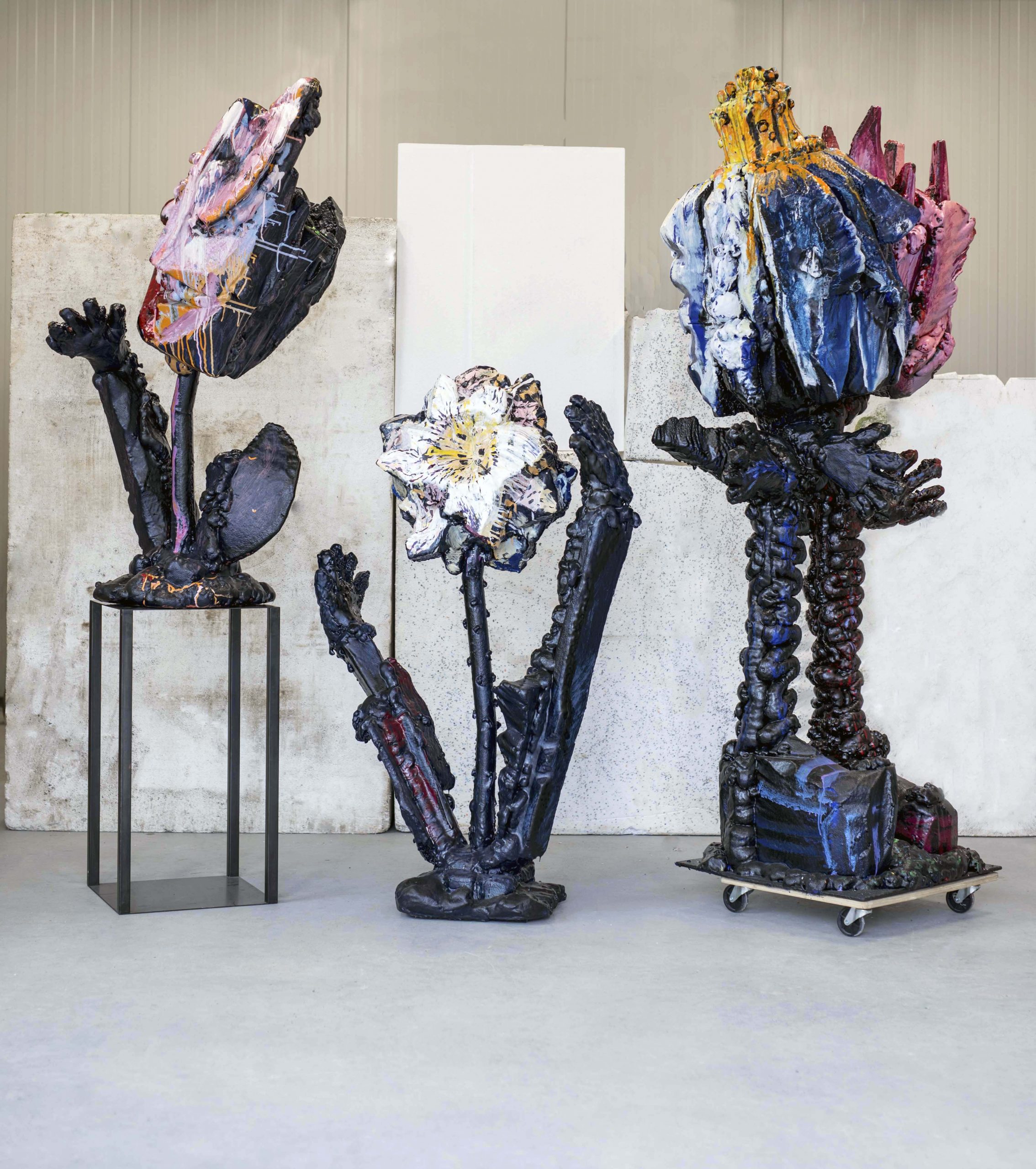
Cecilia Bjartmar Hylta (part of the Prospects exhibition organised by the Mondriaan Fund, courtesy diez gallery)
Cecilia Bjartmar Hylta (1992) often takes themes like infrastructure and urban planning as points of departure for new work. She is interested in how we move though the outside space, in the demands placed on us by structures, and in the reactions these evoke. In her work she tries to mimic public situations in order to visualize their underlying, often invisible, forms and ideas. For the sculpture “Van Nellefabriek” (2023), the artist collected dust from the Distribution Centre which she compressed to form a miniature version of the building. With this sculpture Bjartmar Hylta is thus inverting content and form.
Art van Triest (presented by MPV Gallery)
Control is a recurring theme in the work of Art van Triest: “Central to my work is the human tendency to fight our fundamental fear with a system, to get a grip on the world around us and satisfy our need for control. My work is a visual investigation, in which I question how this system relates to the physical reality of the world around us. With my work I want to offer a visual counterbalance to the simplification and standardization of our environment. I would like to strive for a more realistic positioning of man, in which we can relate to reality in a more complete way”. “Lines” (2023) is a sculptural installation, it explores a balance between systems. It attempts to portray contrasts between possible ways of relating to our environment. Focusing on strength and calculating reliability or arising from a development process it portrays various ways of working and thinking.
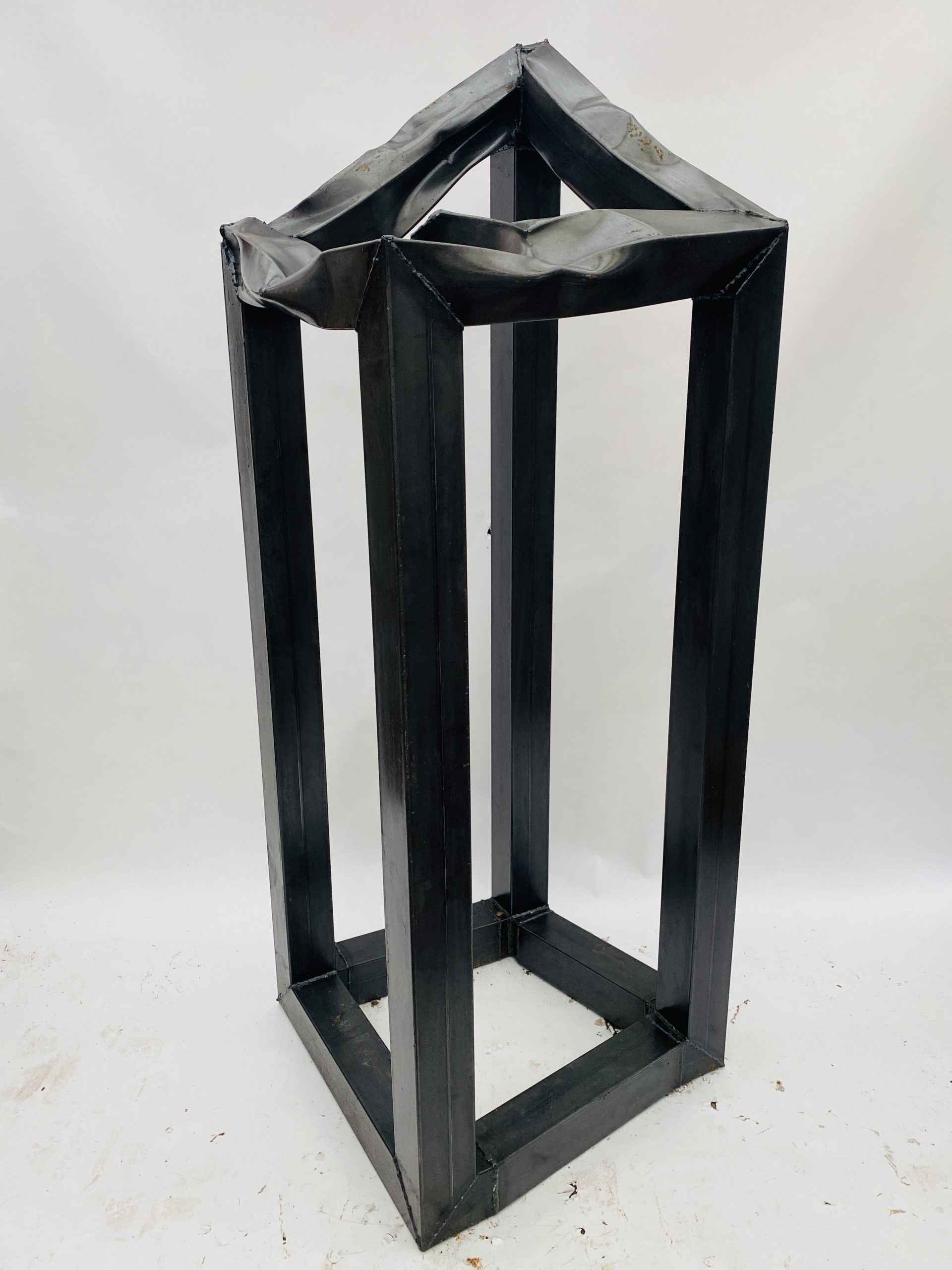
André Kruysen (presented by NL=US gallery)
André Kruysen presents ‘Dependent perspective (whale’s eye)’ (2023). Kruysen’s work relates to daylight and the structure of the architecture around him. He makes interventions in spaces that influence these aspects. These interventions can result in both freestanding and space-merging sculptures. His more complex and chaotic language of form in recent years stems from the increasingly complex (visual) culture in which we live. The search for a personal balance in it finds its form in his work. In the midst of his disruptive spatial interventions, Kruysen seek silence: the stillness that occurs due to the sacred effect of daylight. This contradiction is the basis of his sculptures.

Olaf Mooij
Rotterdam-based artist Olaf Mooij has gained particular renown for his car sculptures in public spaces. At Art Rotterdam, he presents “The Church of our Unbelieving Faith” in a mysterious, chapel-like structure. In this beautiful chapel you fall from one surprise to the next. Having entered you have to let your eyes do the work. “What should I believe?” And “What do I want to believe?” Are questions that stay with you after seeing all those special objects. Do you believe in the sacredness of the technology? Or do you believe that the holy cow is alive and created from an auto-spermatozoid? Is our car such a great invention? Isn’t it better to continue electrically? And to whom do we prefer to leave our fate: the human driver or the self-thinking machine? These kinds of aspects are highlighted in this ‘church’.
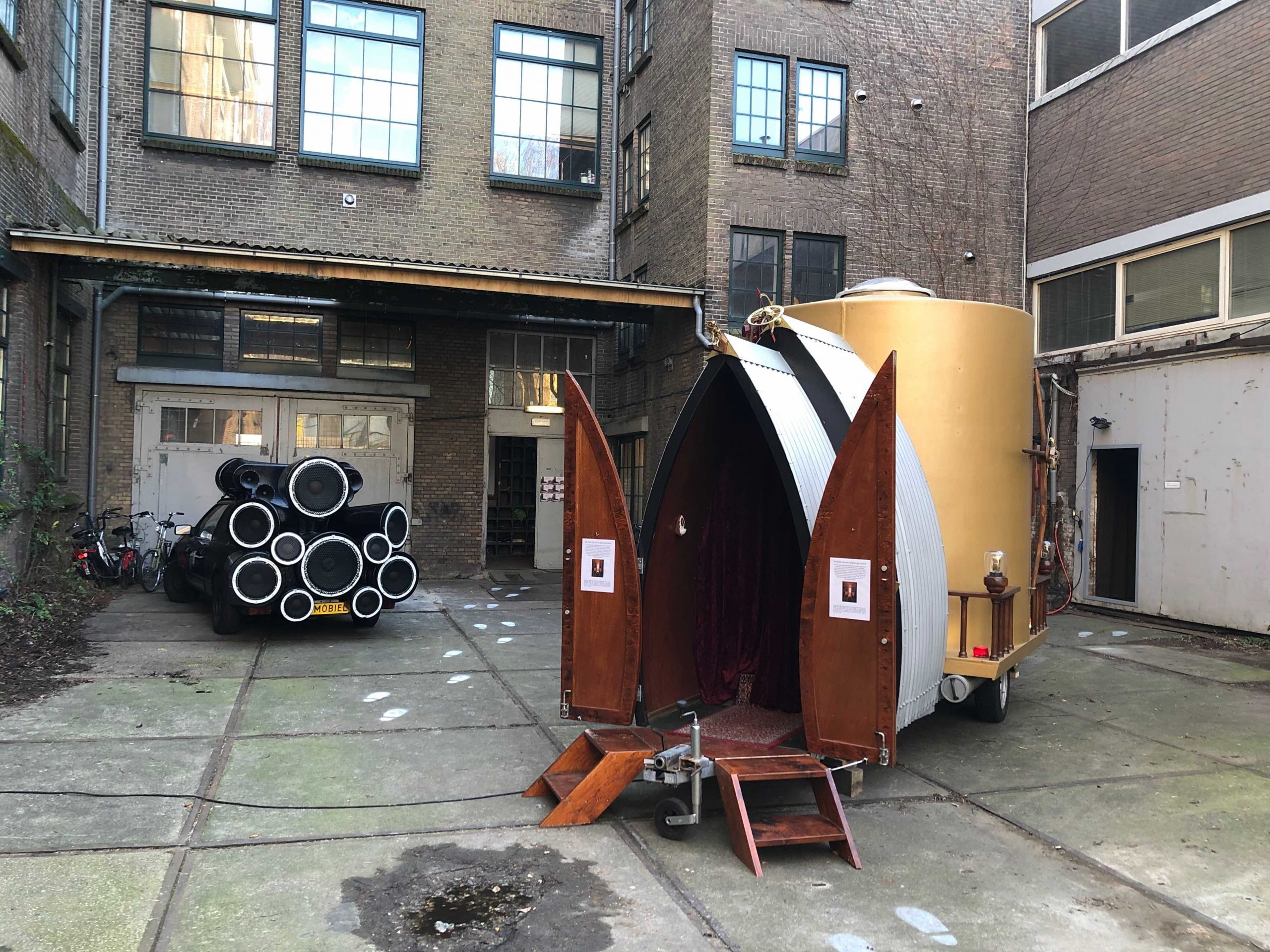
Thordur Hans (presented by Rademakers Gallery)
It is often the familiar and mundane that takes centre stage in the work of Icelandic artist Thordur Hans. His practice revolves around being perceptive of interesting gestures that one might come across in their everyday life. These gestures then develop into artworks in the form of recognisable, slightly modified objects or activities that brings a new perspective to their existence. “Window I” (2021) is a monument to everyday forgetfulness and casual apathy.
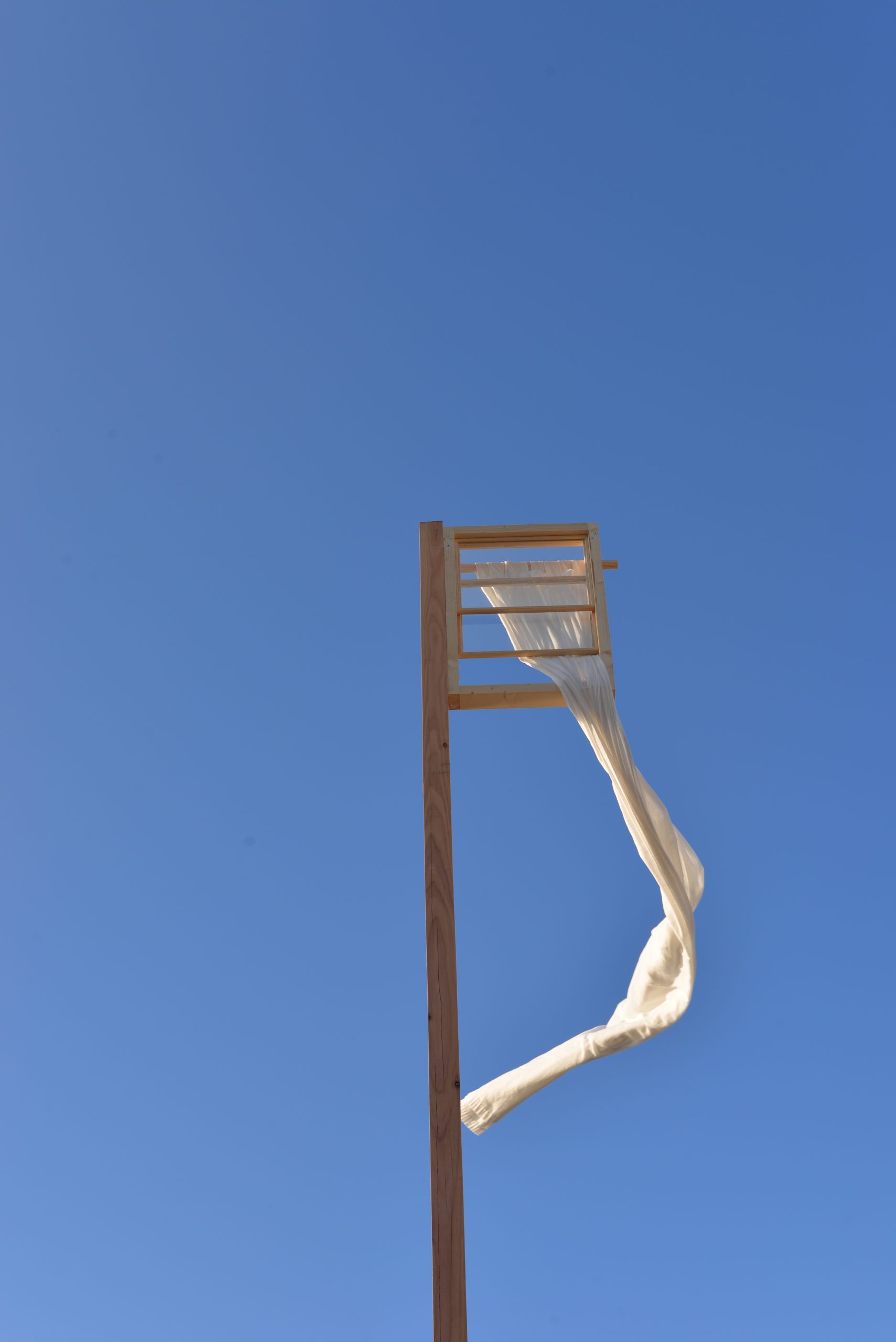
Ruud Kuijer (presented by Slewe Gallery)
Ruud Kuijer is a Dutch sculptor known for his series of large abstract concrete constructions along the quay of the Amsterdam-Rhine Canal near Utrecht, the so-called “Waterworks”. Over the years, Ruud Kuijer has made several large sculptures with flat plates of concrete or iron that hang, lean, lie or stand upright. In “Large Standing Plate” from 2022, a box section and a pipe protrude through a monumental iron plate and keep it visually balanced. The flat surface of a plate is made part of a three-dimensional whole. The front and back of the plate get their own identity. You can walk around it to experience its sculptural character.
Willem Besselink (presented by OMI Rotterdam and NL=US gallery)
The built environment of the city, and the Van Nelle building in particular, consists of an almost infinite number of structures and systems. Willem Besselink is fascinated by the interference patterns that arise in the process, which he visualises in his work. Interference patterns occur when two or more waves, such as light, sound, or water waves, meet and combine. The sculpture “See Through” (2023) is one of the many possible visualisations of the many structures and at the same time contributes to the further accumulation, and its interference patterns.
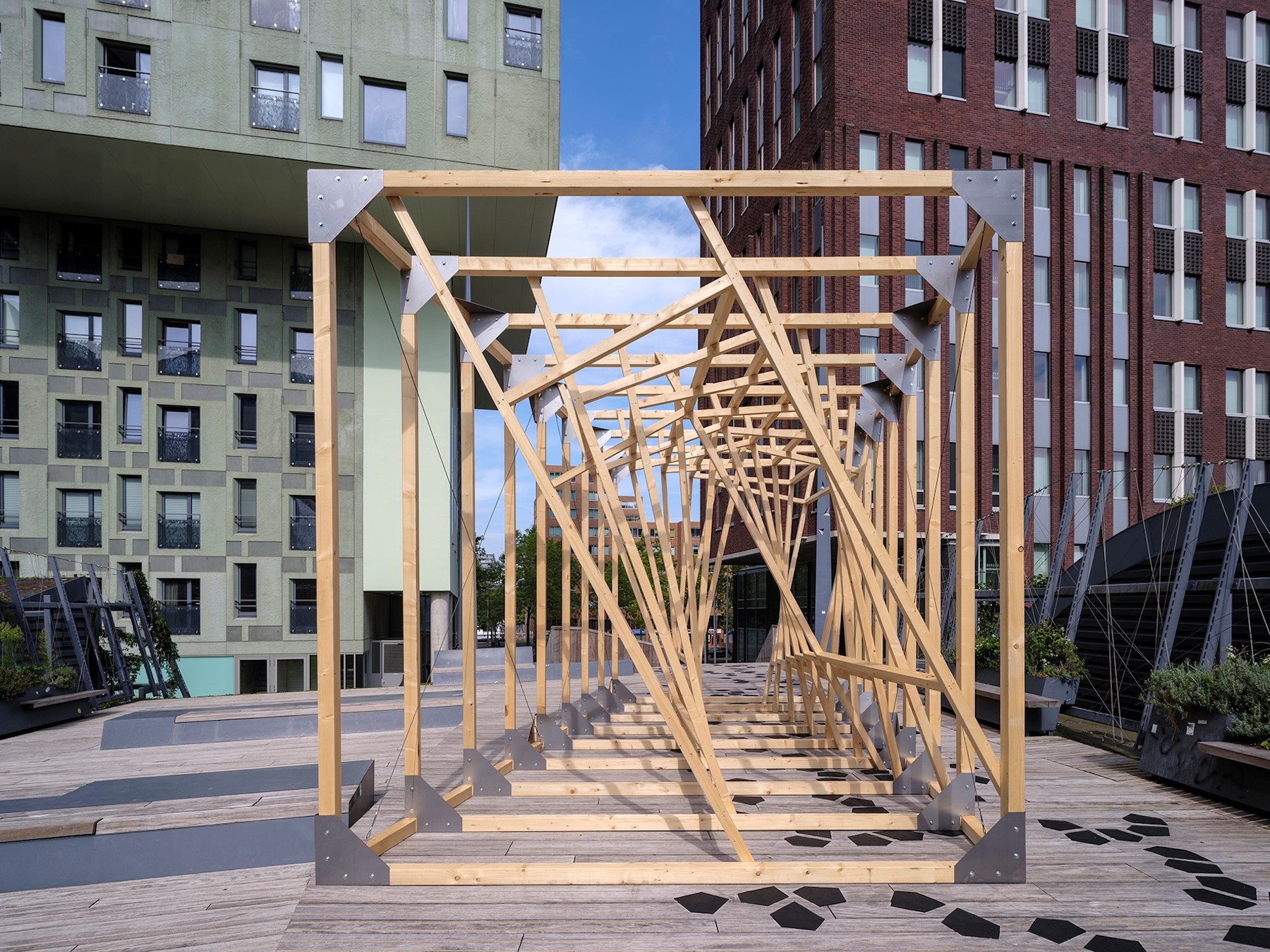
Martinus Papilaja (part of the Prospects exhibition organised by the Mondriaan Fund)
For graffiti artists it is crucial to use a recognizable tag that cannot be traced back to them. This is important because the application of graffiti is forbidden in most places. Martinus Papilaja (1988) considers it a sign of recognition for the specific craft of graffiti that his work is now presented to the public explicitly under his own name. Papilaja studied what the graffiti artist’s need or urge to write is, and how this affects their personal handwriting. He thinks of graffiti as a craft that can be perfected through practice and studying the work of others. For his work at Prospects, Papilaja consciously chose to experiment with form. Rather than spray painting a flat surface, he presents three sculptures outside the Van Nelle Factory that establish his tag spatially.
Sanne van Balen (part of the Prospects exhibition organised by the Mondriaan Fund)
Can language present itself in a different guise? This question is a common thread in the work of Sanne van Balen (1994). After graduating in Dutch language and literature, she went on to study Image & Language at the Gerrit Rietveld Academie. Her artworks focus on the visual experience of language, while her writings give images a voice. For her work at Prospects, Van Balen is zooming in on the tongue. On the one hand, the tongue is a muscle that shapes and literally creates language. On the other, ‘tongue’ also refers to the language we speak, the language of a people. This duality is a recurring feature in her work. Lying in the grass outside of the Van Nelle Factory is the work “Stem” (2024), a red, meandering sculpture somewhat resembling a physical tongue. To Van Balen, the landscape is a linguistic site that both contains and conveys the environment’s meanings.
Erik Buijs (presented by Rutger Brandt Gallery)
Erik Buijs sculpts animated figures from clay or wax, deliberately leaving traces of the sculpting process. His artworks serve as a thought-provoking commentary, stirring curiosity and inviting contemplation. Through the intriguing blend of his figures whimsical and childlike appearance combined with somber undertones, Buijs sculptures embody a peculiar yet powerful presence. These figures, seemingly playful yet oddly peculiar, offer a unique perspective on the human condition. Within their seemingly simple forms lie layers of depth, revealing both sensitivity and idiosyncrasy. Buijs intertwines the weighty aspects of human emotion with the innocent essence of childhood, creating sculptures that emotionally resonate with viewers.
Compiled by Flor Linckens
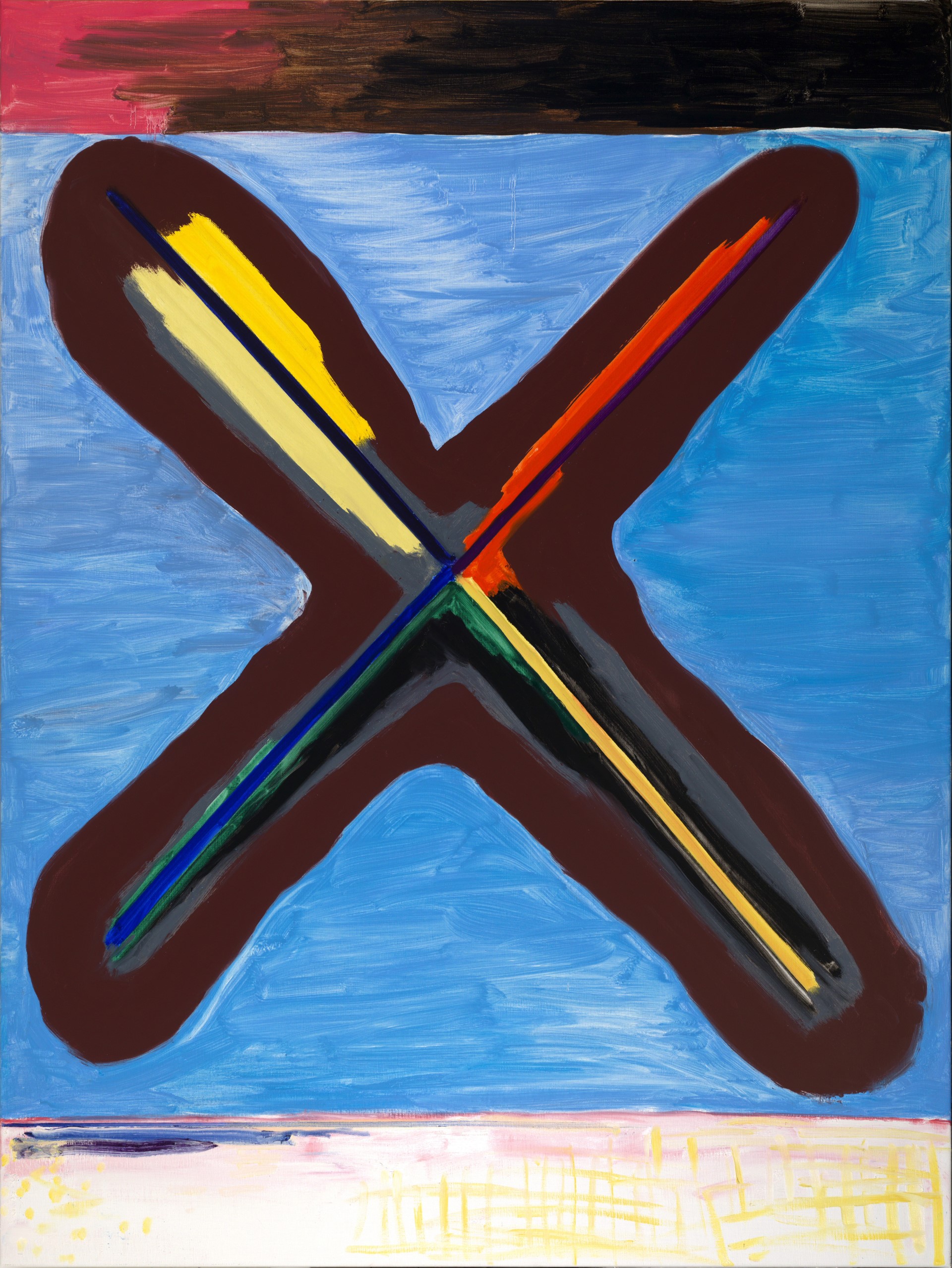
For the eighth year in a row, the NN Art Award will be awarded to a promising artist who completed their studies at an art academy in the Netherlands and is exhibiting at Art Rotterdam. This year, for the first time, the nominees will exhibit their work in the prestigious Kunsthal Rotterdam, from 1 February to 14 April 2024. The nominated artists for the NN Art Award 2024 are Maaike Kramer (Art Gallery O-68), Mónica Mays (Prospects section of the Mondriaan Fund), Jan van der Pol (CREMAN & DE ROOIJ) and Peim van der Sloot (Brinkman & Bergsma).
Dutch artist Jan van der Pol is intrigued by the dynamic interaction between our eyes and our brain when we perceive images. His work is inspired by urban and industrial landscapes, as well as literature and news images. This can result in figurative works or abstract pieces with figurative elements, but in his more recent work, the artist increasingly leans towards abstract and quasi-geometric pieces in a myriad of colours. Since the 1980s, Van der Pol has been compiling a kind of visual diary, consisting of his daily drawings and watercolours. Van der Pol says, “These books often have a central theme and can be seen as works that, due to their form, resemble Chinese scroll drawings, which cannot be comprehended in a single glance. By unrolling them on one end and rolling them up on the other, it gradually reveals small parts to the viewer, so that they can assemble the whole image in their minds.”
The 74-year-old artist was educated at the Rietveld Academy and the Rijksakademie van Beeldende Kunsten in Amsterdam.
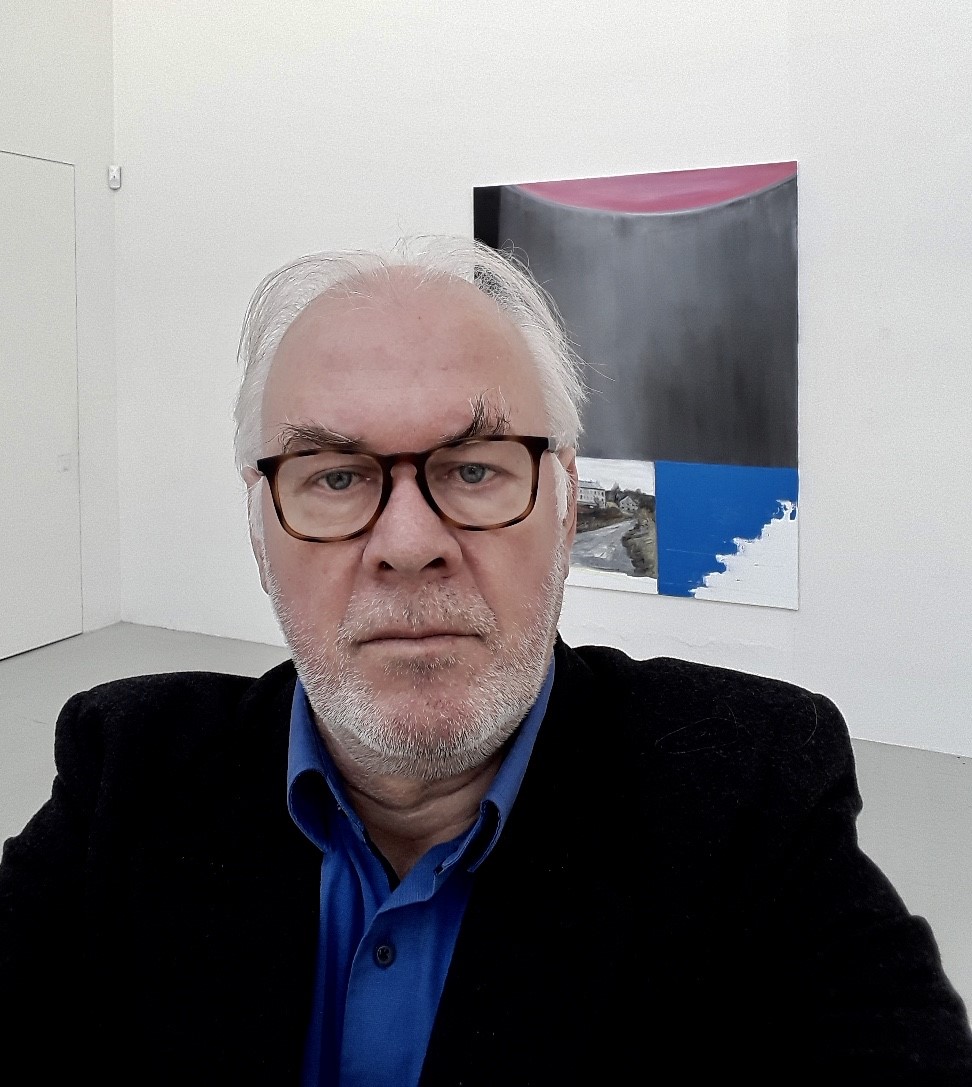
Could you tell us more about the work you will be presenting at Kunsthal Rotterdam?
The works that I will present in the Kunsthal consist of two parts: two large drawings and three small, recent oil paintings. The drawings were made in 2021 and are titled “A Walk of Life”. They all consist of a single line that can be interpreted as a metaphor: where the line begins, viewers can see birth, and at the end of that line, it leads them off the paper — greeted by the Grim Reaper. As for the oil paintings, I can’t say much; I can only recommend that viewers approach them with an open mind, take things in slowly, and perhaps contemplate what they have seen afterwards.
What are your plans for 2024? What are you currently working on?
My plans for 2024 are not very concrete, except for the desire to spend as much time as possible in my studio. Additionally, I have plans for new publications. I view publications as part of my output, and I try to add something to them at regular intervals. In the near future, there will be a publication featuring a coherent series of 26 drawings titled “The Comfort Zone of the Stoic”. It will be the fifth publication in the “A NEW DAY” series.
What is your primary source of inspiration?
If one can speak of sources of inspiration — I generally don’t like to use the word “inspiration” — it might be the incredible complexity of the world and our relationship to it as human beings.
What advice would you like to offer to the new generation of artists?
I taught at the Royal Academy of Art in The Hague for 25 years. Conversations with students were occasionally fantastic, but ultimately, everyone has to figure it out for themselves. And that’s often very enjoyable. Sometimes, there’s a bonus, like being nominated for an award like this, which turns out to be a particularly pleasant surprise.
The winner of the NN Art Award will be announced in the Kunsthal Rotterdam on Thursday 1 February at 20:00 CET. The work of the nominees will be on display there until 14 April 2024. Jan van der Pol’s work will also be exhibited at the CREMAN & DE ROOIJ booth during Art Rotterdam.
Written by Flor Linckens
Interview with Shani Leseman about her presentation at Prospects, witchcraft and magic
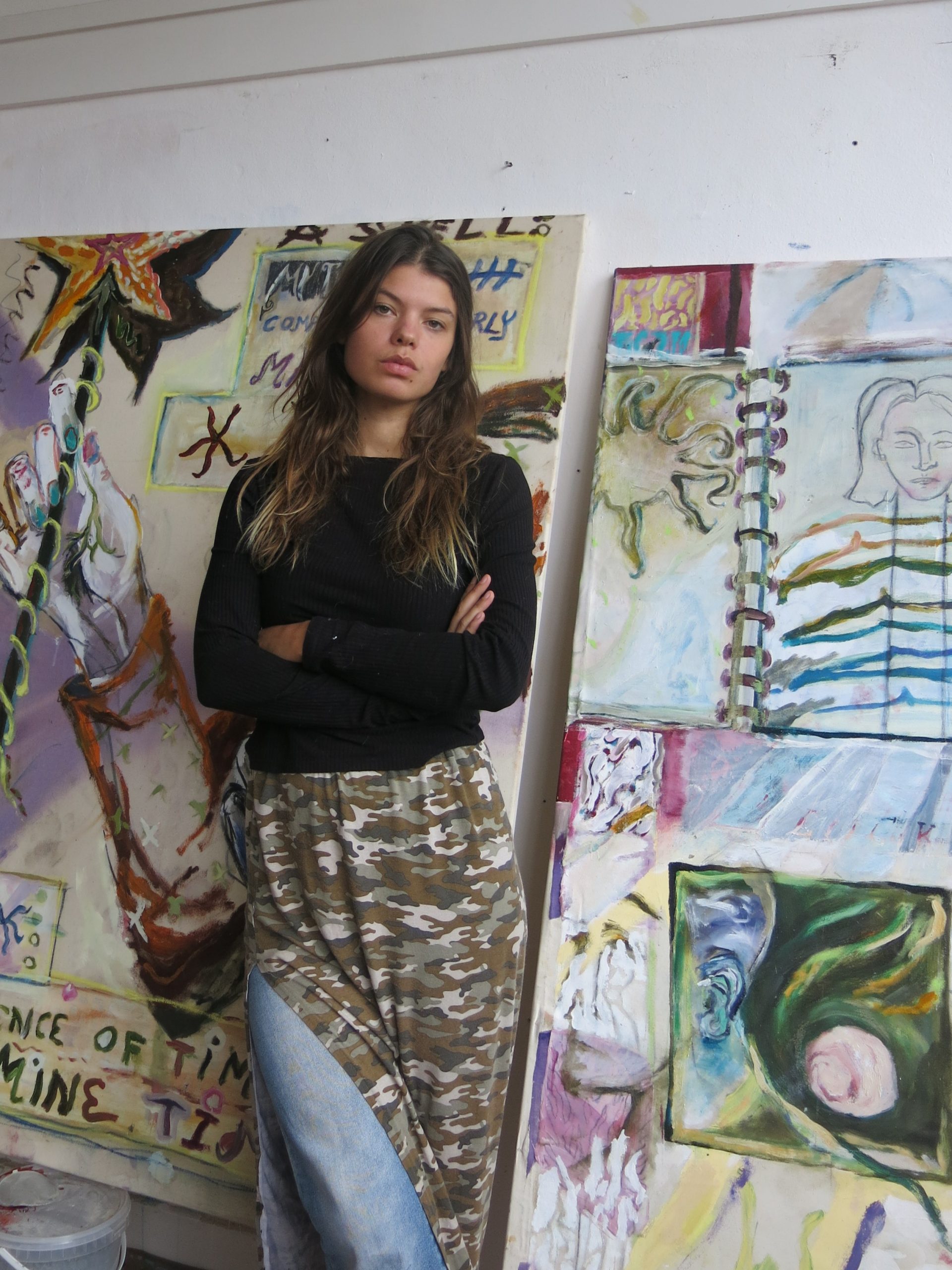
More than ever before, we have structured our world in line with scientific insights and technological discoveries. From the invention of the microscope to the smartwatch, everything is geared towards rationality and efficiency. But not everything is immediately explainable. There is still room for magic. This is the subject of Shani Leseman’s paintings. Her work is filled with spiritual and magical practices, symbolism, rituals and talismans.
Leseman has an eye for what cannot immediately be seen but can be felt. “Often, I only discover what the painting wants to tell me after I’m finished. I consider the process of painting a way to access the subconscious. Visual art often communicates in the language of dreams, symbols and rituals.”
Shani Leseman (Curaçao, 1996) lives and works in The Hague, where she studied at the Royal Academy of Art (KABK). Currently, she is enrolled in a course to become a witch, or to put it in more friendly terms, a practitioner of magic, which involves dealing with forms of energy and connecting with the inner world. This aligns well with her artistry, as both practices, Leseman claims, focus on intuition and intention. At Art Rotterdam, Shani Leseman’s work can be seen in the Prospects exhibition.
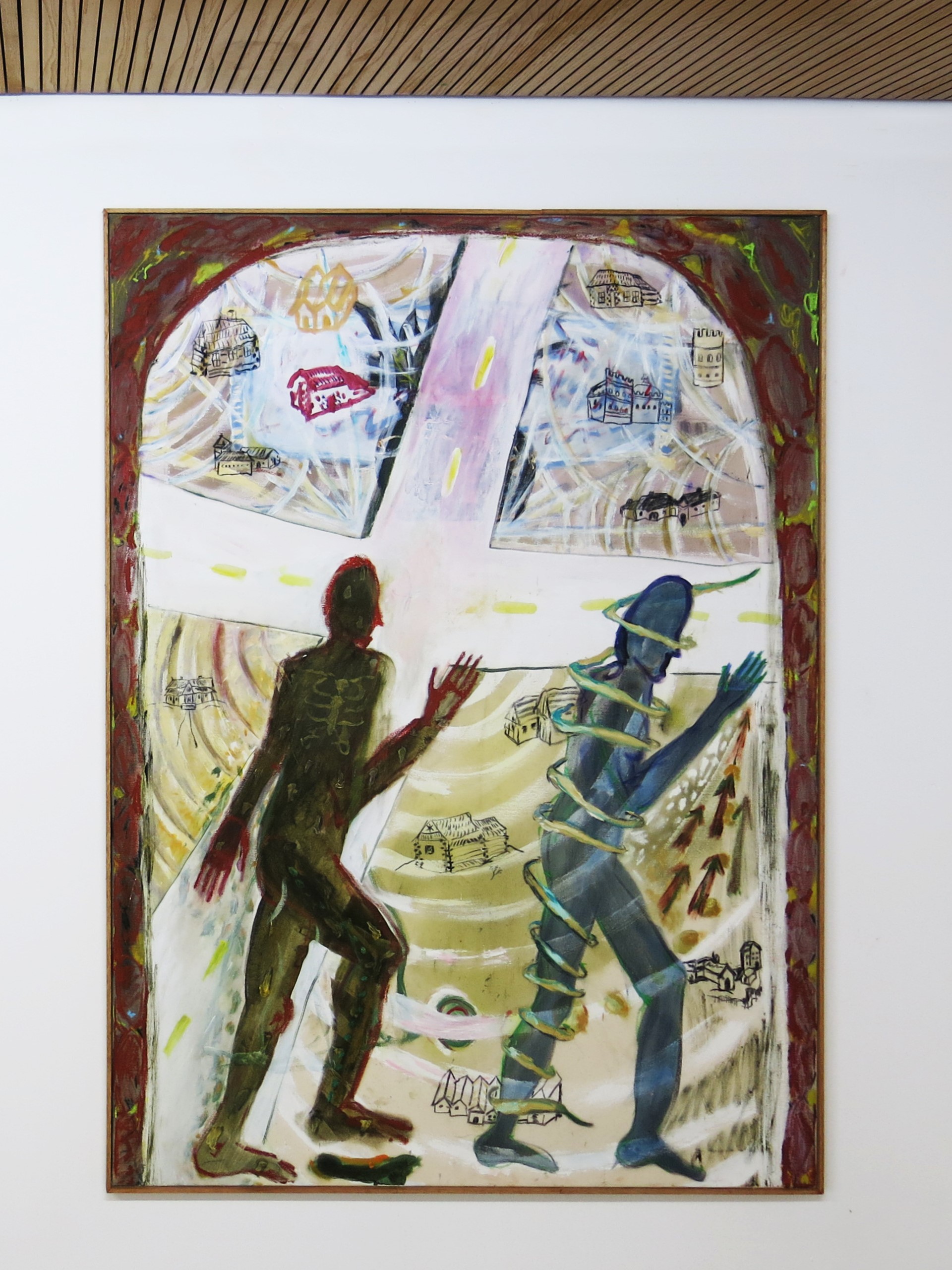
Congratulations on your presentation at Prospects. What can we expect to see?
Thank you! At Prospects, I am presenting five canvas paintings that I created over the past year. They touch on various topics within the overall theme of magic, such as spells, magical objects and places.
You mention magic as the overall theme of the Prospects presentation. Is magic also the general theme of your work?
My work is about the invisible and unexplainable, that which cannot immediately be seen but can be felt. It revolves around spiritual and magical practices, symbolism, intuition, rituals and objects as carriers of meaning.
You spent part of your childhood on Curaçao. Throughout the Caribbean region, magic plays a more significant role in daily life than here. Did your fascination with magic in an everyday context originate there?
Yes, I believe I encountered a naturalness in the belief and use of magic during my childhood on Curaçao. At the same time, magic is something universal and can be found everywhere in the world, in different times and forms. Europe also has rich spiritual roots.
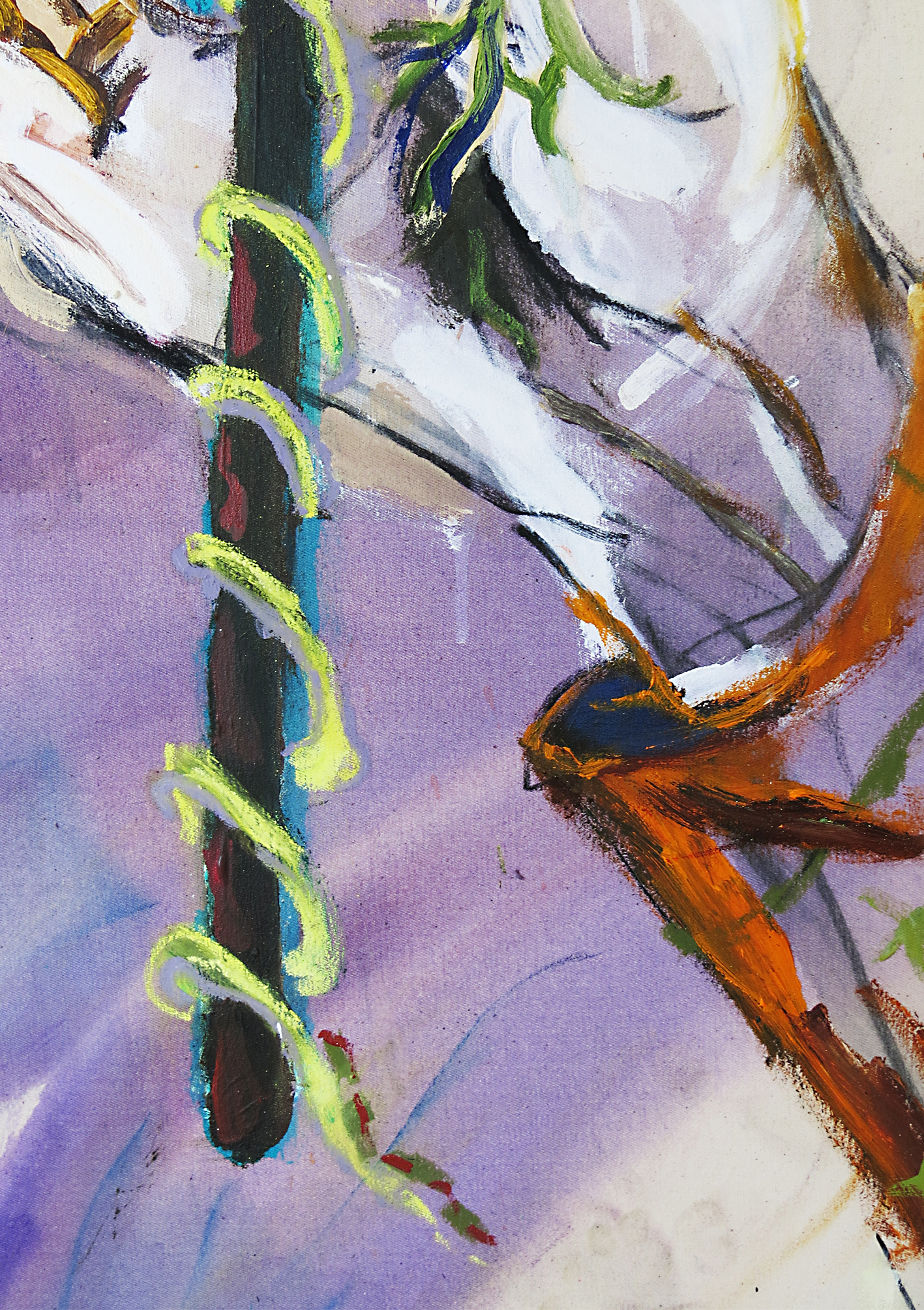
In addition to being an artist, you are a practicing witch. What does that entail?
Witchcraft is not an organised religion and has no fixed rules or frameworks; there are many different styles and practices. What a witch does varies from person to person. In general, a witch, or practitioner of magic (a less loaded term), focuses on the inner world and its connection to the living world around us. Living because the basis of magic is the idea that everything is energy or contains energy. Rivers, plants, humans and other animals, but also things unseen, like feelings and thoughts, consist of energy. Working with magic is consciously noticing, changing or guiding this energy. The practice and philosophy of witchcraft arises from a sense of kinship and focus on protecting life forms that need our support. It has an ecological and activist character.
I read that you are undergoing training for this. What does that training involve?
I am apprenticing with a witch who practices traditional Dutch witchcraft. During my training, she is teaching me about various practices within witchcraft and how to perform them, such as creating rituals, charging magical objects, divination and talismans. The foundation is to develop a strong connection with your intuition through daily exercises.
Is it something you can incorporate into your artistic practice?
Yes, I see many similarities between the practice of a witch and that of an artist. In both practices, intuition and intention are central (for me). An example of how both practices are intertwined can be seen in the work Talismagic, for which I made 100 ceramic talismans. These objects are not references to talismans; they are the magical objects themselves. During the creation of the sculptures, I charged each object with a specific intention. For example, there is a talisman for setting boundaries, one to counter gossip and one for better sleep.
The first time I saw your work was when you were nominated for the Royal Award for Modern Painting. You had submitted the work An altar for dogs. Is such an altar piece typical of your work?
That work is based on an altar piece I encountered on the street while traveling. I was struck by this spontaneous encounter with something magical – I suddenly found myself standing before a carefully assembled whole, consisting of emotionally charged objects. I consider this found altar a physical expression of a feeling that perhaps had nowhere else to go. In such an altar piece, I see the human urge for rituals, for practicing magic. I cannot know the specific intention of the creator with certainty, but I can feel or guess it. I called it An altar for dogs perhaps for the maker’s dogs or for dogs in general. I also recognised my own dog and altars I had made for him in this.
Dogs are a recurring element in my work: this refers to the bond between humans and other animals. As mentioned earlier, the foundation of witchcraft lies in connecting the inner world with all living things around us. I think witchcraft is currently experiencing a revival because it is crucial for the way people interact with other animals and plants to change. The vision within witchcraft calls for a re-evaluation of the environment, an awareness that we share the world with other beings. I find it important to speak out about animal rights and advocate for those without a voice, both in altars and on the street.
I consider the assembly of my paintings in general as the creation of an altar piece, where various elements with symbolic meaning (both personal and universal symbolism) come together for a specific purpose or intention. Sometimes the intention is clear beforehand, such as expressing gratitude or creating an ode, but often I only discover what the painting wants to tell me after I am finished. I consider the process of painting a way to access the subconscious. Visual art often communicates in the language of dreams, symbols and rituals.

Another recurring element in your work is the hand. Hands have a symbolic function in multiple cultures and religions, so I wondered what the hand represents in your work?
In my work process, there is a lot of room for intuitive, quick drawings, often with charcoal. I make many of these, almost like automatic writing, and then I use a selection as the basis for paintings. The hand does indeed appear frequently, without me knowing in advance why or what it represents exactly. Often, I only later discover the personal meaning of these symbols, as with the hand. In my work, it often stands for humanity. Where religion places a god at the centre, within magic, it’s the human and the ability to effect change. Through our hands, we create, connect and heal. When I imagine where energy leaves my body, it is also through the hand.
Last year, you received a grant from the Mondriaan Fund. Is there a project you were able to execute with the grant that you wouldn’t have been able to otherwise?
In addition to various investments in my practice, the Mondriaan Fund grant allowed me to carry out the production of the previously mentioned work, Talismagic, both in terms of material costs and the time invested in each object. The contribution was also crucial for creating the paintings shown at Prospects: the most valuable aspect is having the peace of mind to spend a lot of time in my studio with the canvases.
What are you currently working on?
I am starting a collaboration with Isabel Cavenecia soon. We have a duo show in March at POST as part of the Symbiosis Series. We were put into touch with each other by curator Fenne Saedt due to our shared interest in witchcraft. Another ongoing collaboration is with Trees Heil, under the name My Guides and Me, where we explore spirituality and magic in video and music. Our first songs and performance were created with Piyoyo (Rik Mohlmann). I am also interested in working with glass. I had a small preview of that during my residency on Aruba last November.
Written by Wouter van den Eijkel
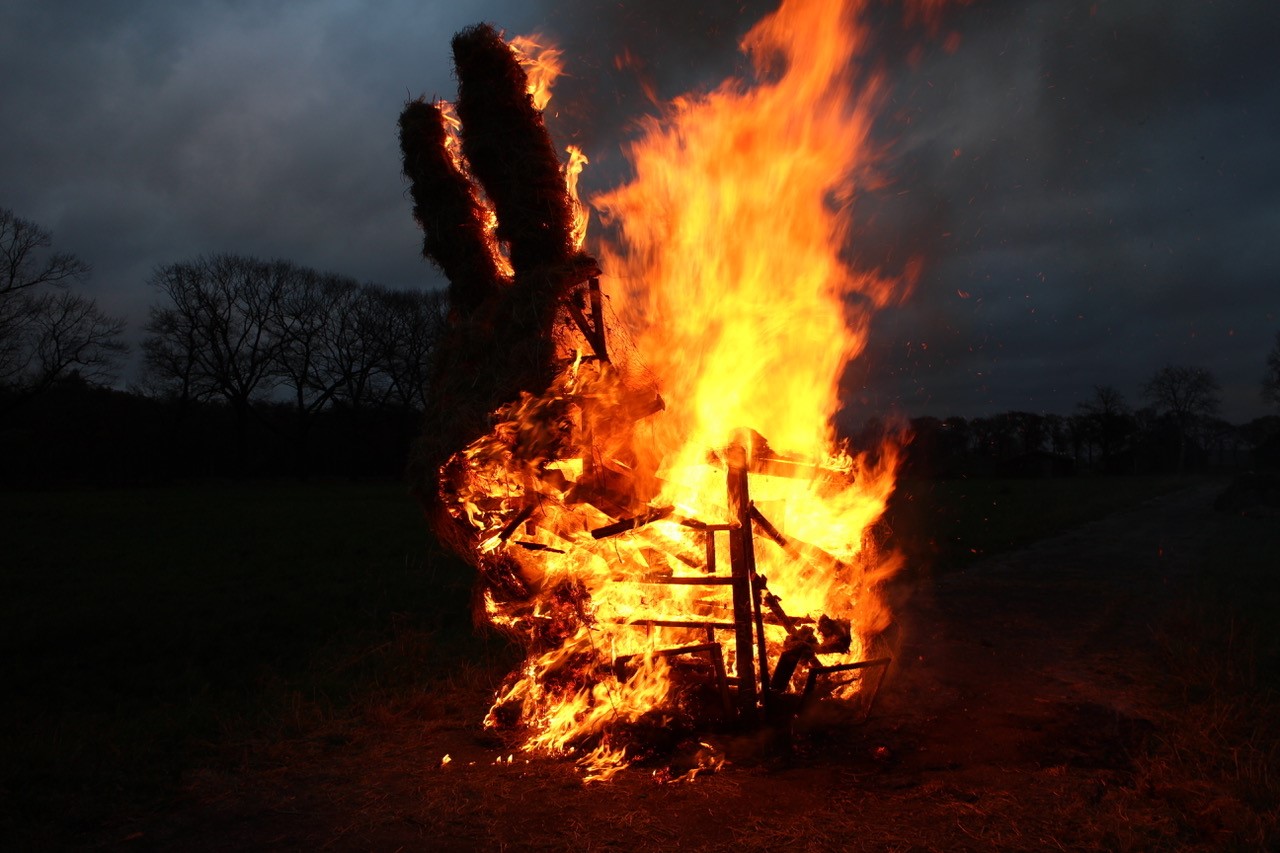
Undoubtedly, the most striking booth at Art Rotterdam will be that of the Annet Gelink Gallery. No one will be able to casually pass by a 3½-meter-high rabbit made of hay. For his new project, tentatively entitled De Gloeiige, Erik van Lieshout temporarily traded his residence and workspace in Rotterdam for his hometown of Deurne, an agricultural village on the Brabant side of the Peel that has become a focal point in the resistance against nitrogen policies in recent years. Van Lieshout spent a year there capturing footage for a new film, creating sculptures of eggs and the hay rabbit. Handmade T-shirts, crafted by Van Lieshout in collaboration with Rotterdam fashion designer Jeroen van Tuyl, are also available for purchase.
“Have you ever stood in a barn with a thousand pigs?” Erik van Lieshout asks somewhere in the middle of our conversation. There is a brief silence. “See, that’s the point; the city and the countryside are two worlds that don’t often interact.” That is precisely what Van Lieshout aims to do with his project: bring these two worlds into contact with each other, even if it means causing a bit of friction.

De Gloeiige
Erik van Lieshout’s latest project takes its working title from the regional myth of a ghostly apparition observed at night in marshes and marshy heathlands. In one version of the legend, the ghost is a farmer who had tampered with boundary markers. After their death, the spirits roam around, trying to reconcile before finding peace.
While De Gloeiige (which translates as ‘the glowing one’) closely follows political events, Van Lieshout has previously created works about farmer protests. The unruly demonstration in front of the Friesland provincial government building in 2019 was the subject of a large collage made from coloured vinyl, just like the tractor protests in The Hague the following year. Protests and challenging the status quo are recurring themes in Van Lieshout’s work. This traces back in part to his upbringing in Deurne, where village politics have been traditionally dominated by the interests of pig and chicken farmers. Van Lieshout’s parents were not farmers, making him an outsider and giving him a love-hate relationship with the local farmers.
Very positive
“It’s a really hardcore industry and the farmers know that something has to change,” Van Lieshout summarises the situation, “because we’re up to our ears in manure here.” With the film he is currently editing, he hopes to bring about sustainable change in the region. Apart from farming, there is little to do in the Peel, according to Van Lieshout. “There are no bike paths, beautiful walking routes or coffee bars, and aside from the Wieger, no museums. I want to change and transform the area into something enjoyable.” For this reason, Van Lieshout refers to his project as “very positive for farmers”. But this is not as straightforward as it may sound because the farmers were not initially open to an exchange with an artist. “Farmers tend to keep to themselves and nowadays, they are especially wary of the media and animal rights activists,” says Van Lieshout. For De Gloeiige, it helped that he came from Deurne and spoke the language. Van Lieshout was transparent about his intentions – “they know I’m a left-wing activist” – and thus gained their trust. He gradually earned their trust and permission to film everywhere. What also helped is that, according to Van Lieshout, the region has a lot of humour. Despite the serious message, humour is not lacking in Van Lieshout’s work or in the film. At the festive conclusion of the project the day after the parliamentary elections – one of the hay rabbits was to be burned while everyone enjoyed a bowl of pea soup and beer – everyone who contributed to the project from the neighbourhood showed up, much to Van Lieshout’s surprise.
While occasional friction is only natural, it enhances the film. Van Lieshout welcomes collectors and museum delegations, bringing them into contact with the farmers. An uncomfortable gathering, not least because some urbanites are vegetarians. This underscores Van Lieshout’s point that urbanites and farmers rarely encounter or know each other.
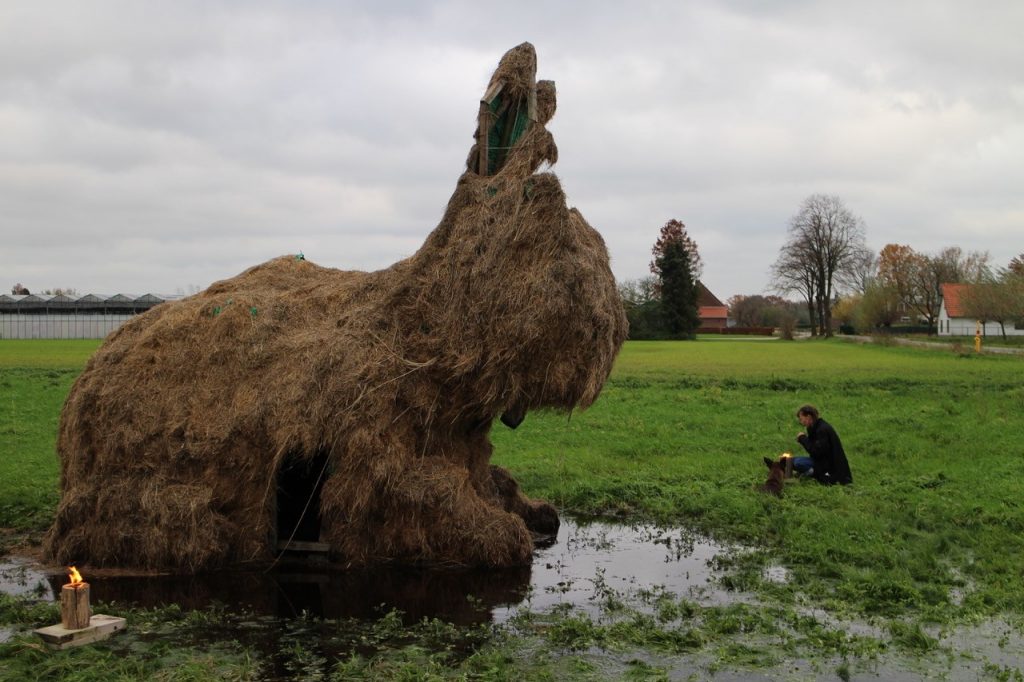
A towering rabbit
Van Lieshout not only addresses the separate worlds of the city and countryside, but also poses the questions of who owns the land and what can be done with it. He gained access to the ruins of a farmhouse, owned by a veterinarian who, like Van Lieshout, left the region to study. The veterinarian now wants to return to start a laboratory developing a serum for snakebites. This would involve testing on laboratory rabbits. The plan faces strong opposition, not only from activists, but also local farmers. In response, Van Lieshout decided to build a towering rabbit made of salvaged wood covered in hay on the veterinarian’s land, a provocative imitation of the hay structures that farmers set up along the road in protest against nitrogen policies.
Another location that plays a prominent role in the film is the area behind the ruins: a vacant 250-hectare terrain. Originally intended for greenhouse development, the financial crisis of 2008-2013 prevented any progress. The development of this area is a hot topic in the municipality. Some residents want nothing to be done with it, while local farmers would prefer a manure fermentation factory, allowing everything to remain the same.

Farmers’ art and T-shirts
The veterinarian allowed Van Lieshout to use everything he found in the ruins for his work. Planks, belts, pitchforks and spades were all incorporated into sculptures. But the main component is the white eggshells. Van Lieshout purchased the eggs from a local farmer. Using a needle, Van Lieshout pierced a hole and blew out the contents. He used the empty eggs in a series of sculptures that might be called farmers’ art. The imagery refers to farm life and Catholicism – the comparison to a rosary is easily made with a chain of eggshells – two pillars that shaped and continue to shape life in the region. Some of these sculptures will be exhibited at Art Rotterdam at the Annet Gelink Gallery booth.
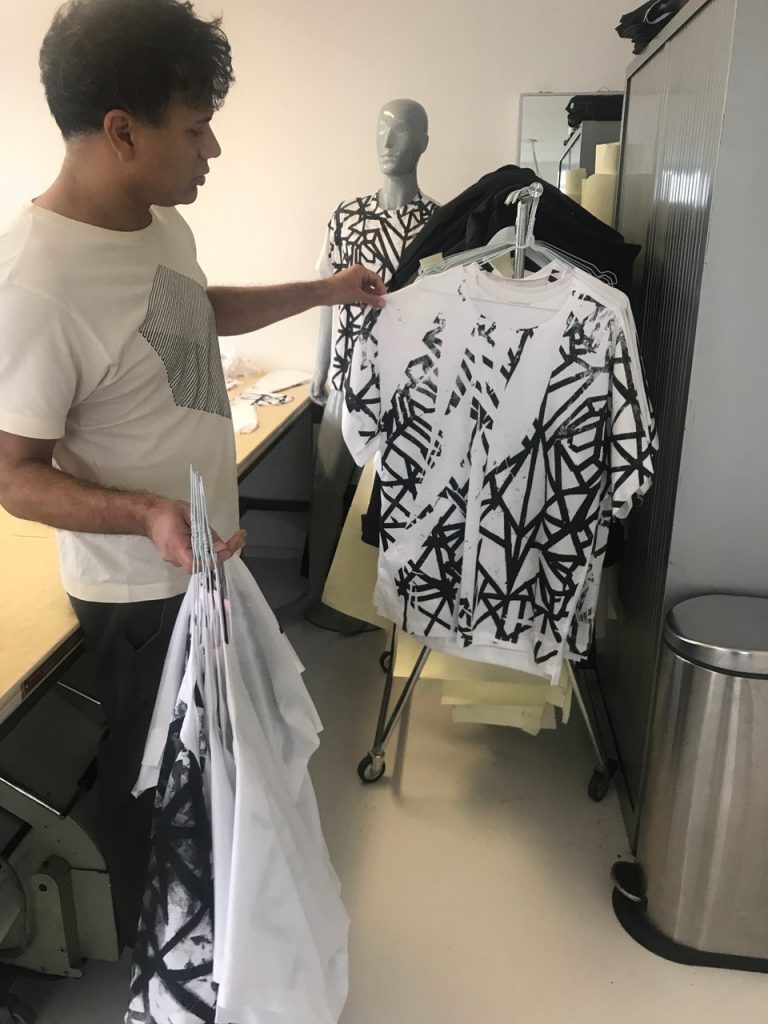
A self-made T-shirt is also available for purchase in a limited edition of 50, resulting from Van Lieshout’s collaboration with Rotterdam fashion designer Jeroen van Tuyl. Van Lieshout used Van Tuyl’s logo, a kind of mask, as inspiration for a sketch, which ended up as a Mondrian-like drawing with sleek vinyl lines. Van Lieshout and Van Tuyl screen-printed an enlarged version of it on white cotton. Each shirt has its own – often double – print in typical raw Van Lieshout style. Van Tuyl created the design. “Putting it together is meticulous work; the entire family has been involved and we’re still working on it,” says Van Lieshout, who hopes to have the 50 shirts ready for Art Rotterdam.
Written by Wouter van den Eijkel